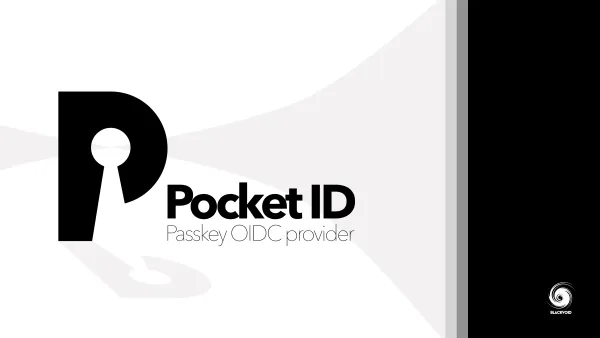Synology DS423+ review
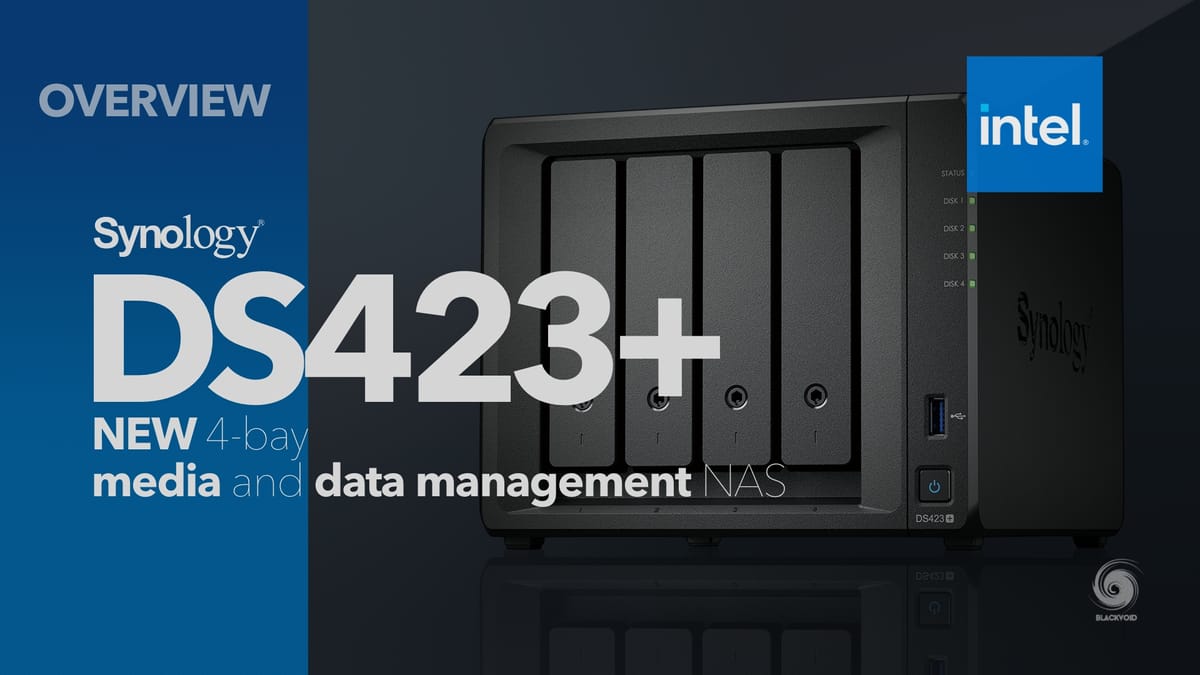
Table of Content
: Intro
: Packaging
: SSDs, 3rd party HDDs and NVMe storage pools
: Setup & DSM installation
: Compatible packages & apps
: Speed tests
: Media streaming and transcoding (PLEX)
: Conclusion
: Intro
Back at the end of February, we had more than a few new Synology model announcements, and of them was the refresh for one of the 4-bay models, the DS423+.

While the most important details were discussed in the overview article, in this one we will take a deeper look into, what looks like, the last Intel-powered plus device of this generation.

Synology marketing is advertising this unit as "data and media management", meaning that unlike its bigger and stronger 4-bay counterpart, the DS923+, this NAS will focus on a multi-user setup with enough power to drive any official package and on top of it all, satisfy the users that are expecting a media-friendly server with transcoding capabilities.
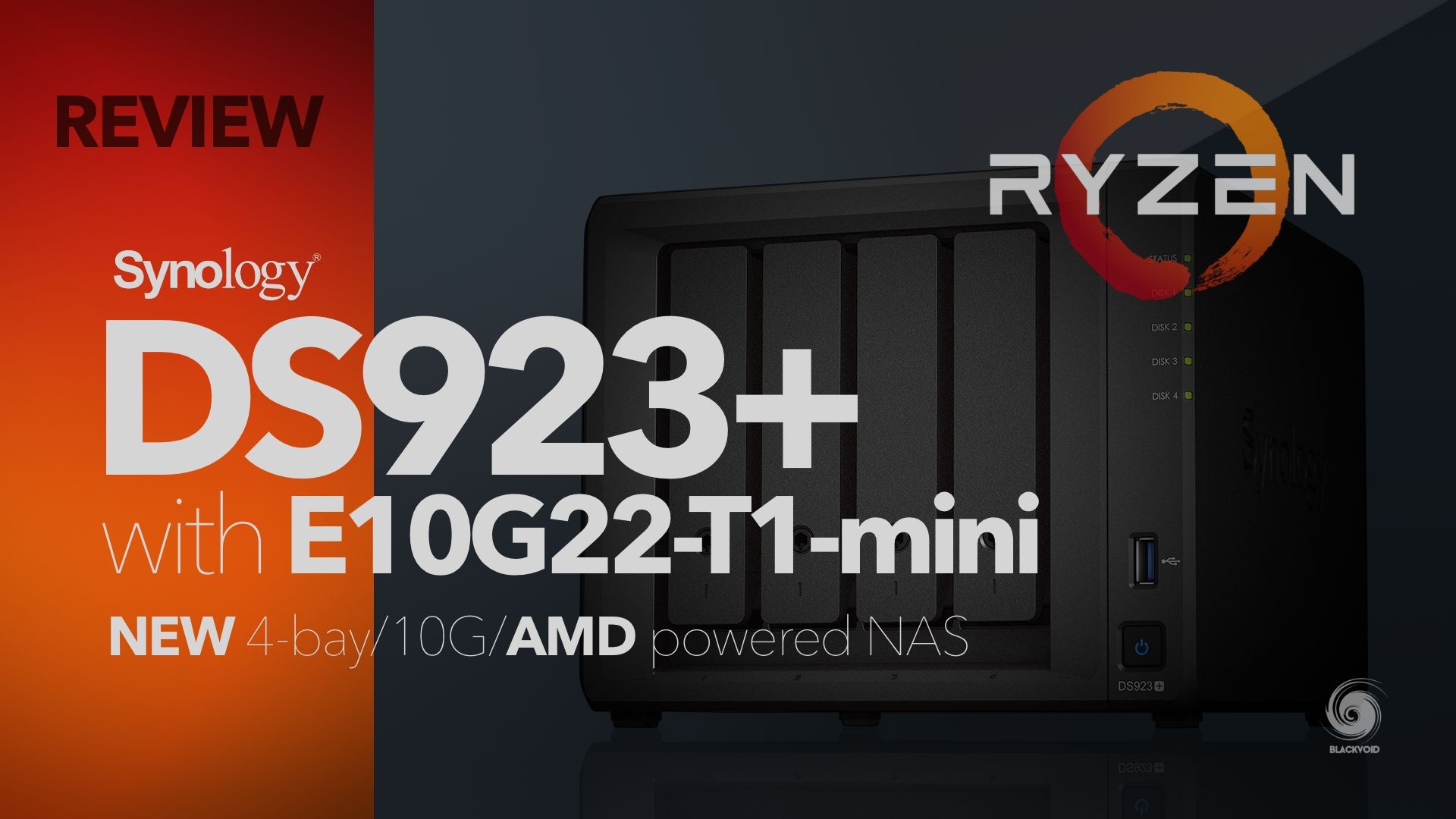
DS923+ full review - another 4-bay NAS built for performance
An all-in-one data management and sharing platform
The DS423+, unlike the before mentioned DS923+, is powered by a well-known Intel Celeron J4125 quad-core with up to 2.7GHz, and 2GB of DDR4 memory (up to a total of 6GB). On top of this, it has two UBS 3.2 Gen 1, as well as two 1GbE network ports on the back.

On the back of the unit, there is a pair of 92 mm vents to keep it all cool and silent as possible inside this 2.18 kg heavy machine. As with all models in this class, the DS423+ comes with an external power adapter, two RJ-45 network cables, and a 3-year warranty that can be extended to 5y via Extended Warranty Plus program.
As it was with the previous model, the DS423+ supports four 2,5" or 3.5" drives inside the main bays, as well as two additional M.2 NVMe drives on the bottom of the unit for cache or user-manageable volumes (only with Synology SVN3400 series drives) that is a new feature with all x23 models so far.
The NAS is powered with a 90W PSU, and in terms of power consumption it will use about 28W while accessing the NAS, all the way down to about 8W while in hibernation. This will depend on the actual drives being used, so the values could go up or down depending on the actual setup. On top of this in an idle state with four Synology drives, the noise level is just below 20 dB(A).
Full data sheet specs are here.
Centralized Data Storage - Store up to 72 TB of data in one place, maintain 100% data ownership, and enjoy multi-platform access
Dependable Performance - Up to 226/224 MB/s sequential read/write throughput supports stable data transfers
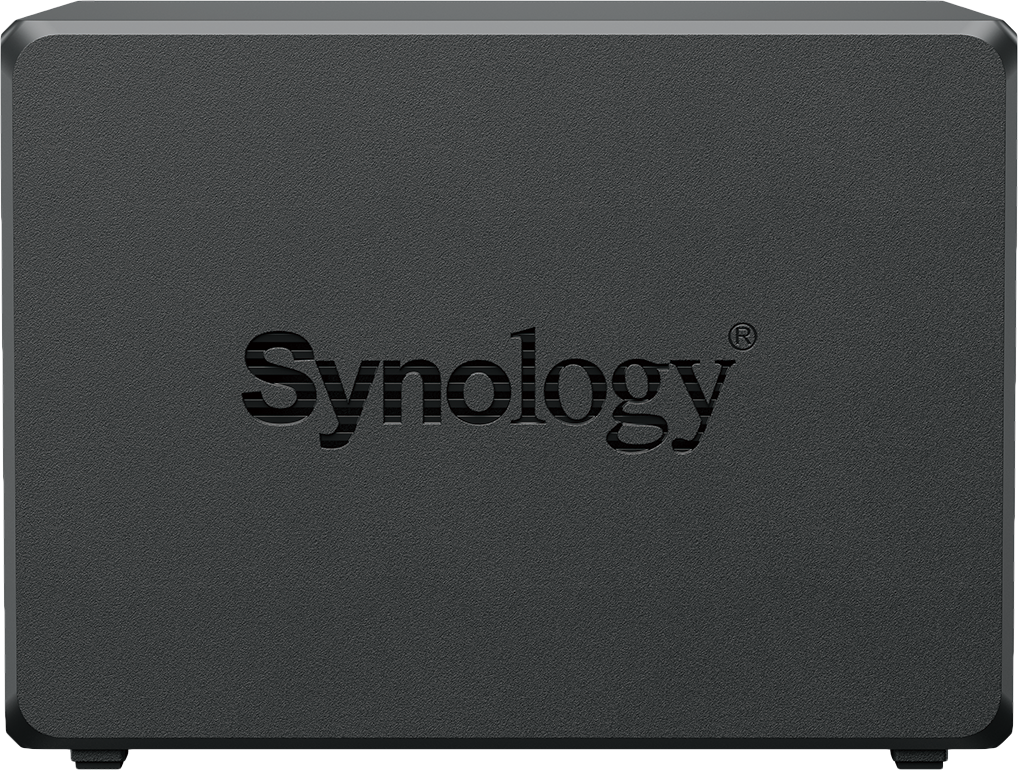
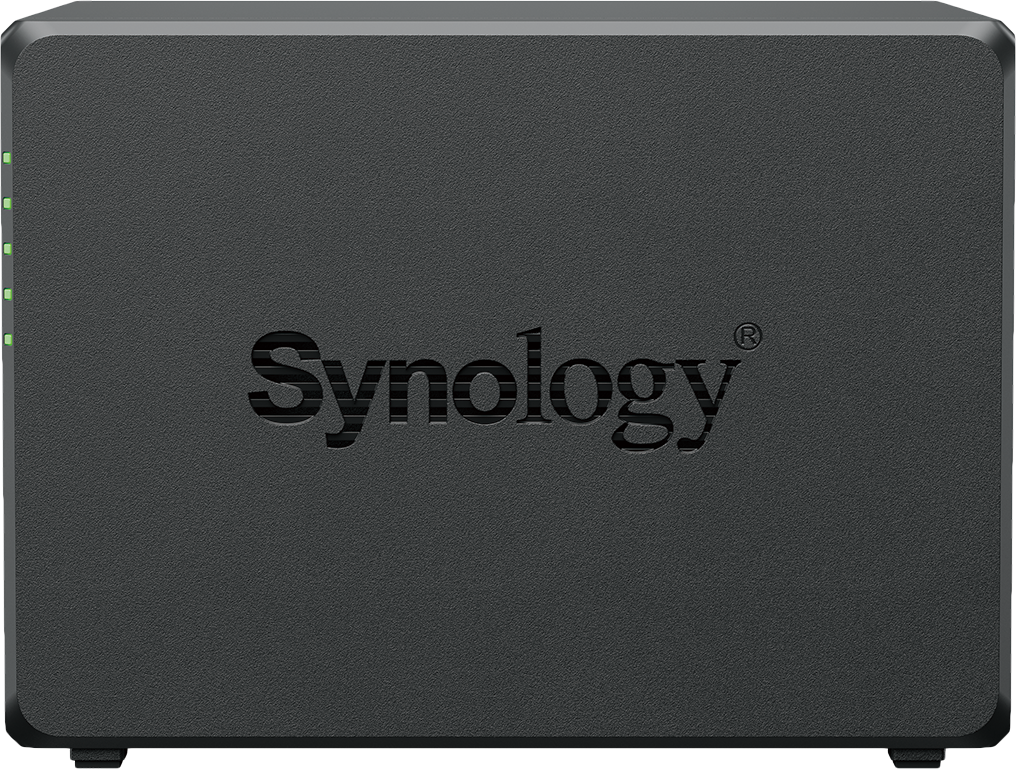
Left and right side view - ventilation openings as part of the Synology logo
: Packaging
Similar to all other 4-bay packagings, the DS423+ is no exception. Apart from the NAS the content of the package comes with an external power adapter, two RJ45 ethernet cables, as well as a pair of keys for locking the drive bays.


The NAS is compatible with both 2.5" and 3.5" drives that can be mounted inside the trays without any screws. This applies to the 3.5" models. With 2.5" ones (typically SSDs), those will have to be secure in place with screws from the bottom side as the trey side brackets are not designed for that drive format.


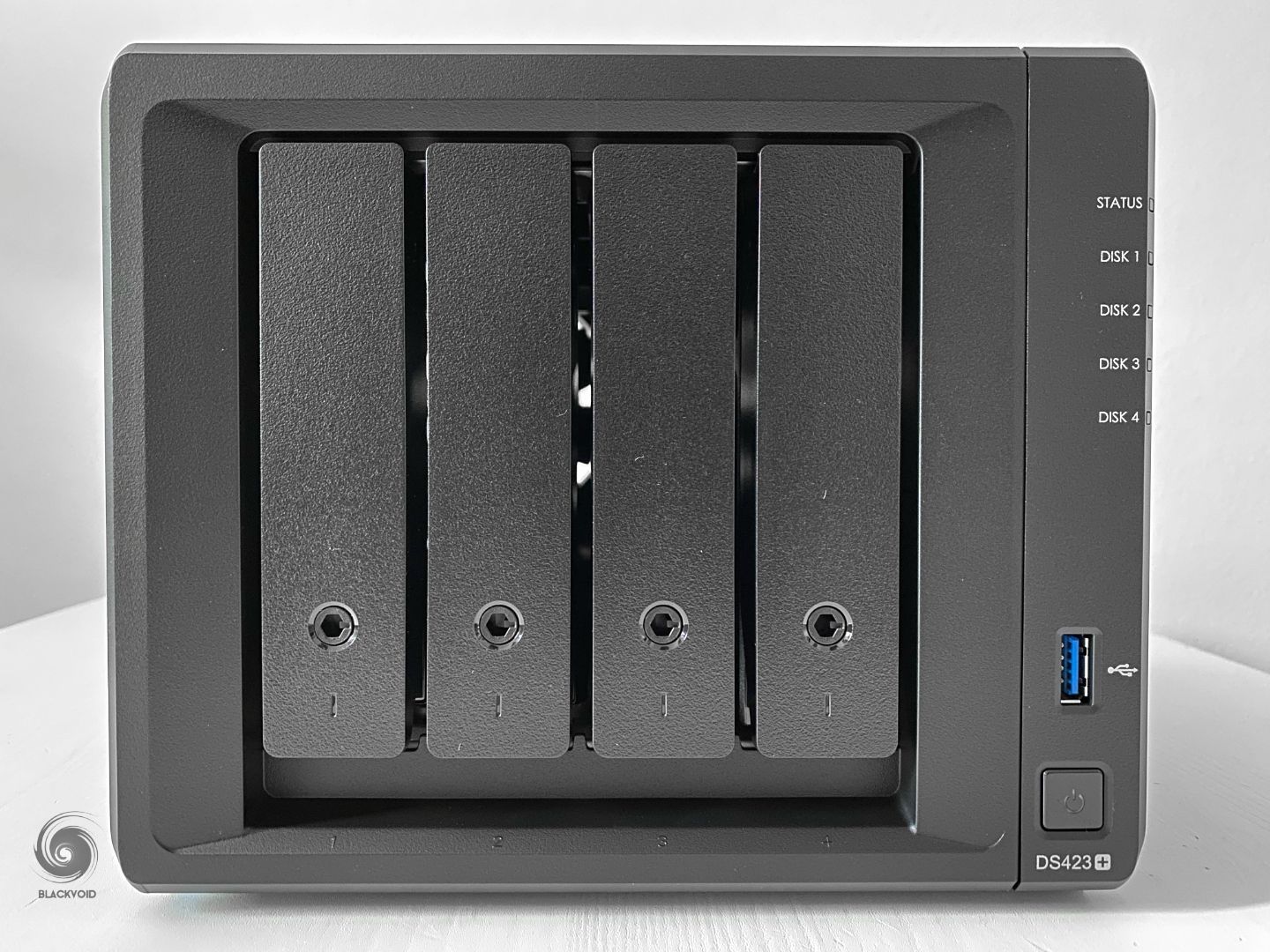

True and tested familiar design
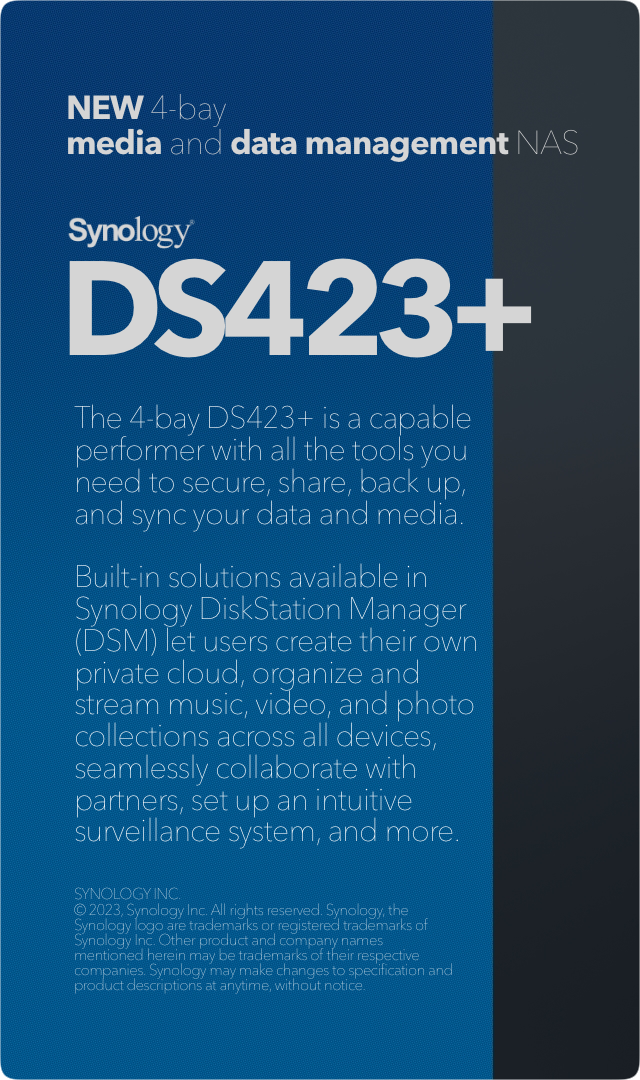
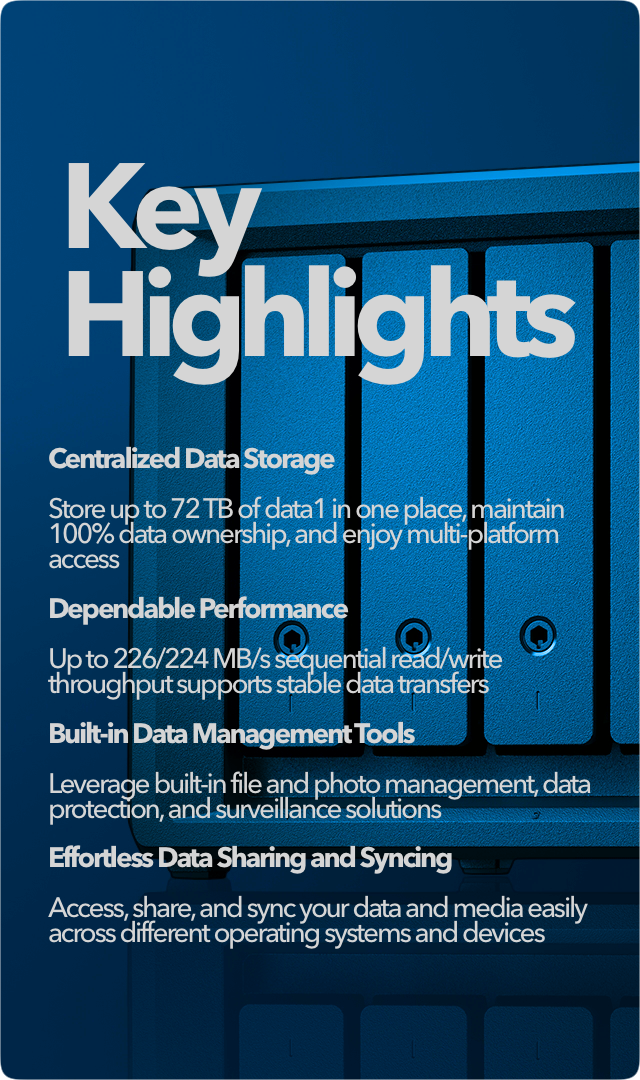
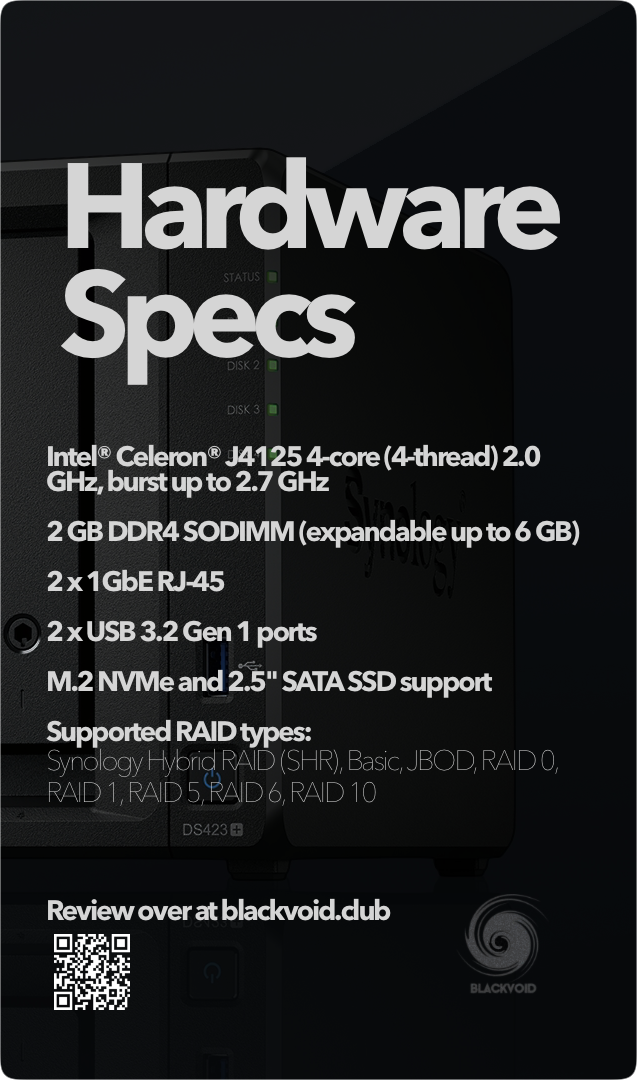
: SSDs, 3rd party HDDs and NVMe storage pools
If we look at the compatibility side of this NAS in terms of HDDs and SSDs, we can see that just like all the rest of the non-plus and plus models for the previous generations, the DS423+ is following in the same footsteps.
Over at the compatibility page for this model, it is obvious that there is a long list of supported drive models from both Synology as well as most 3rd party vendors.
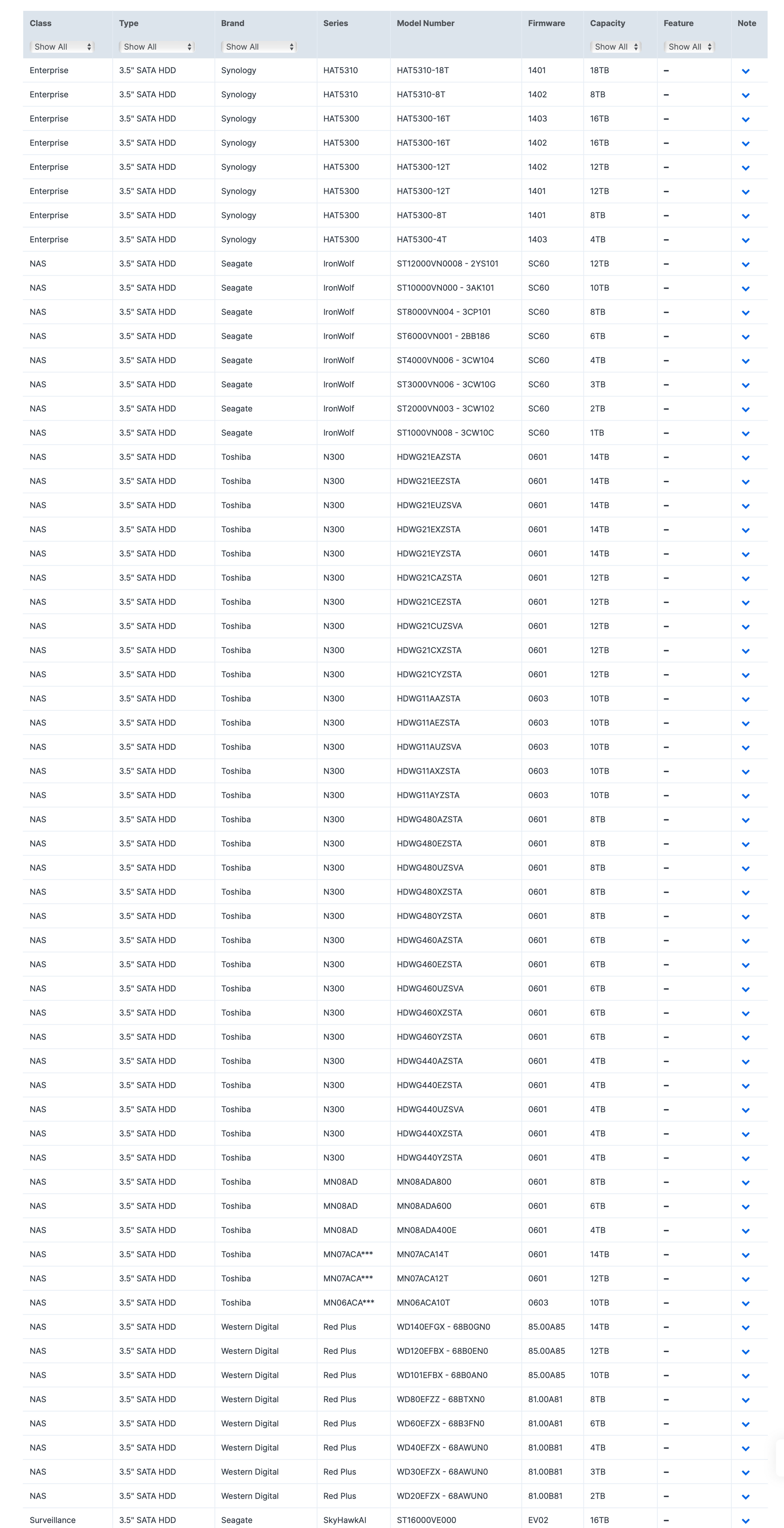
Always be sure to check the list before buying the NAS or the drives to avoid any potential issues with compatibility as well as any support problems that might arise from it.
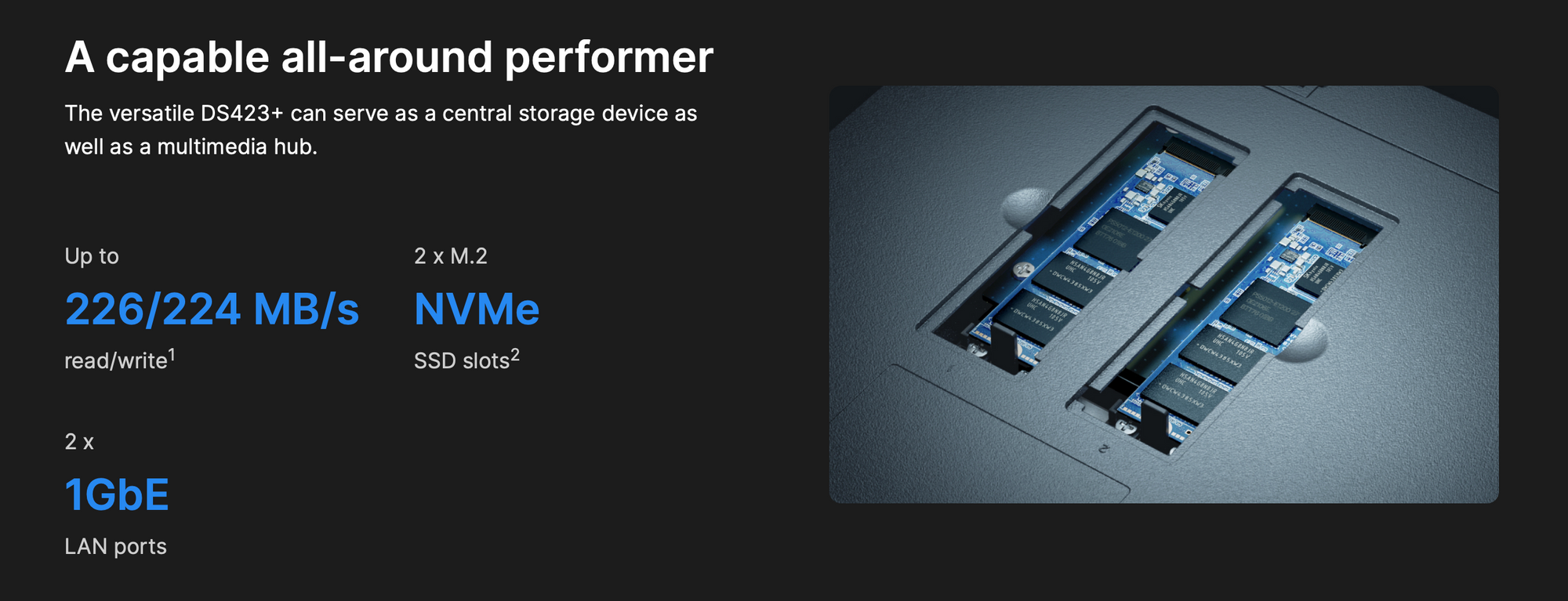


NVMe slots on the bottom side of the NAS

The DS423+ supports M.2 2280 NVMe slots on the bottom of the unit and those can be used for both caching and usable volume space. However, if we plan on using the drives for storage, keep in mind that in that case, we will have to use Synology SVN3000 series drives, as 3rd party models will not work. Those will work for caching, but not for user-usable volume.
: Setup & DSM installation
After the NAS has been connected and powered on, with the help of the Synology Assistant desktop app it was detected on the network. The DSM version it came with was 7.1.1.-42933 at the time of this article.
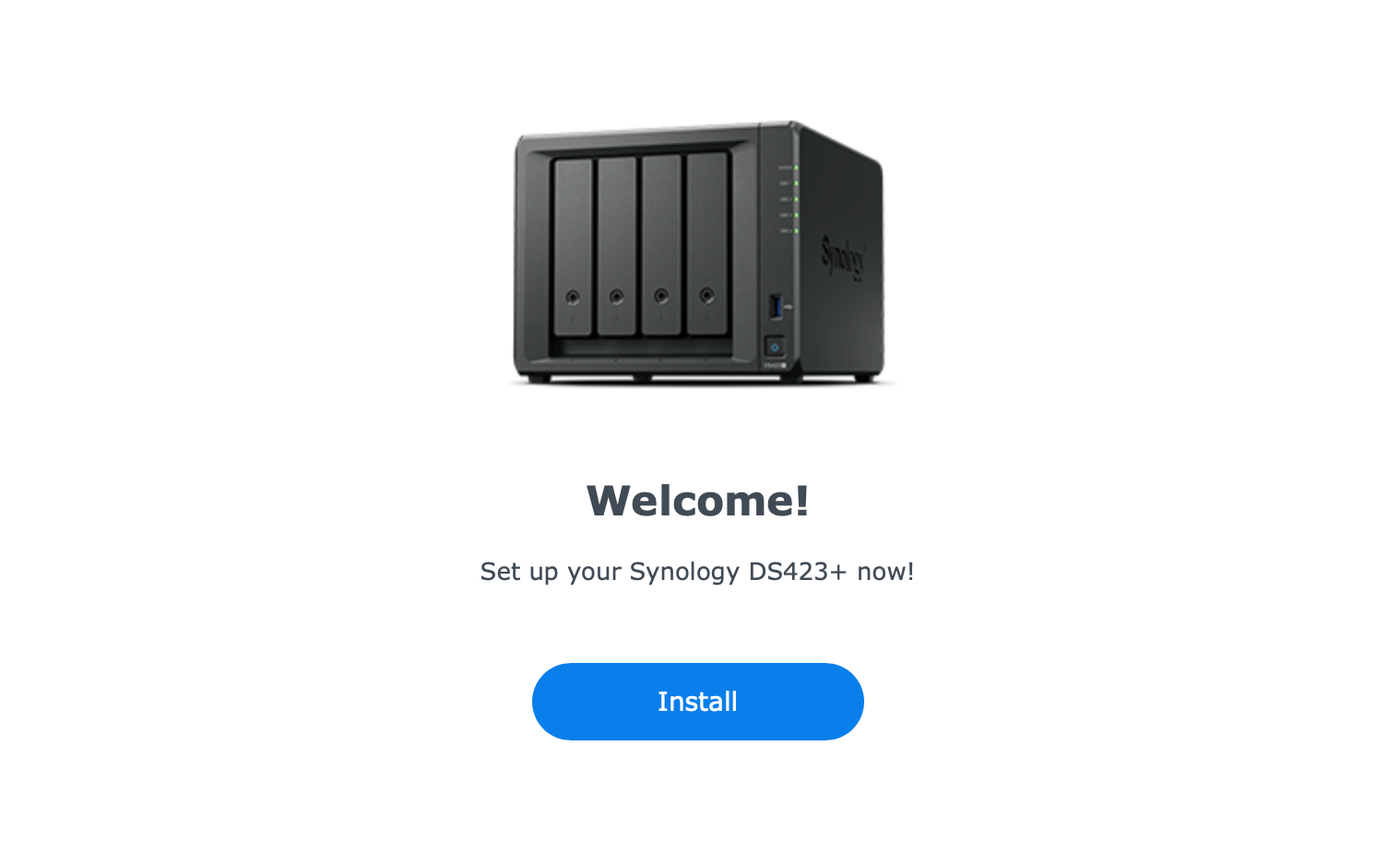
That is the minimum version that it came with, but the NAS still needs a fresh DSM installation considering that the drives inside have no OS installed. Because of that, the next version we can install is in fact DSM 7.1.1-42962 which can be downloaded from the Synology website, or as a manual upload.
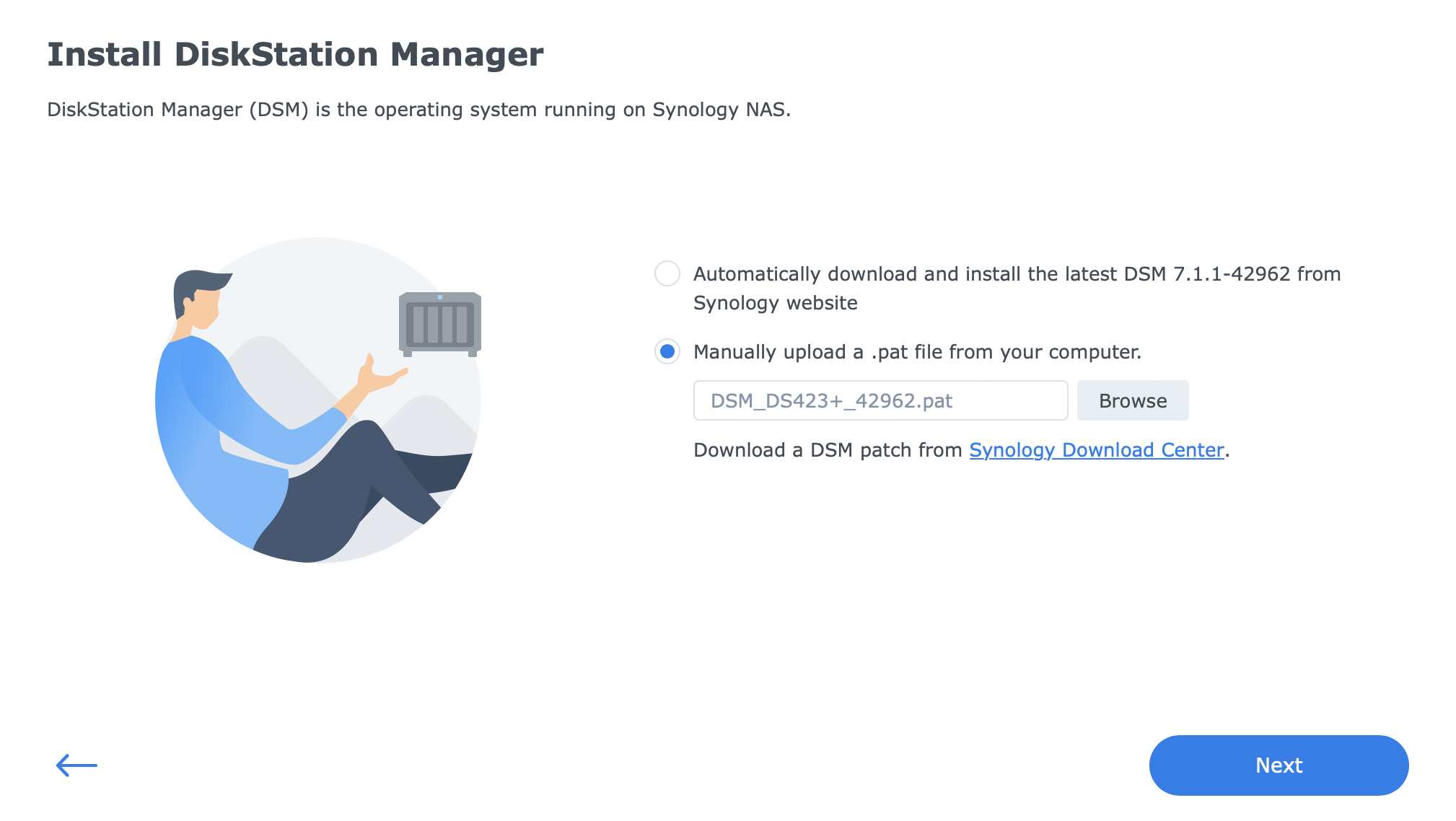
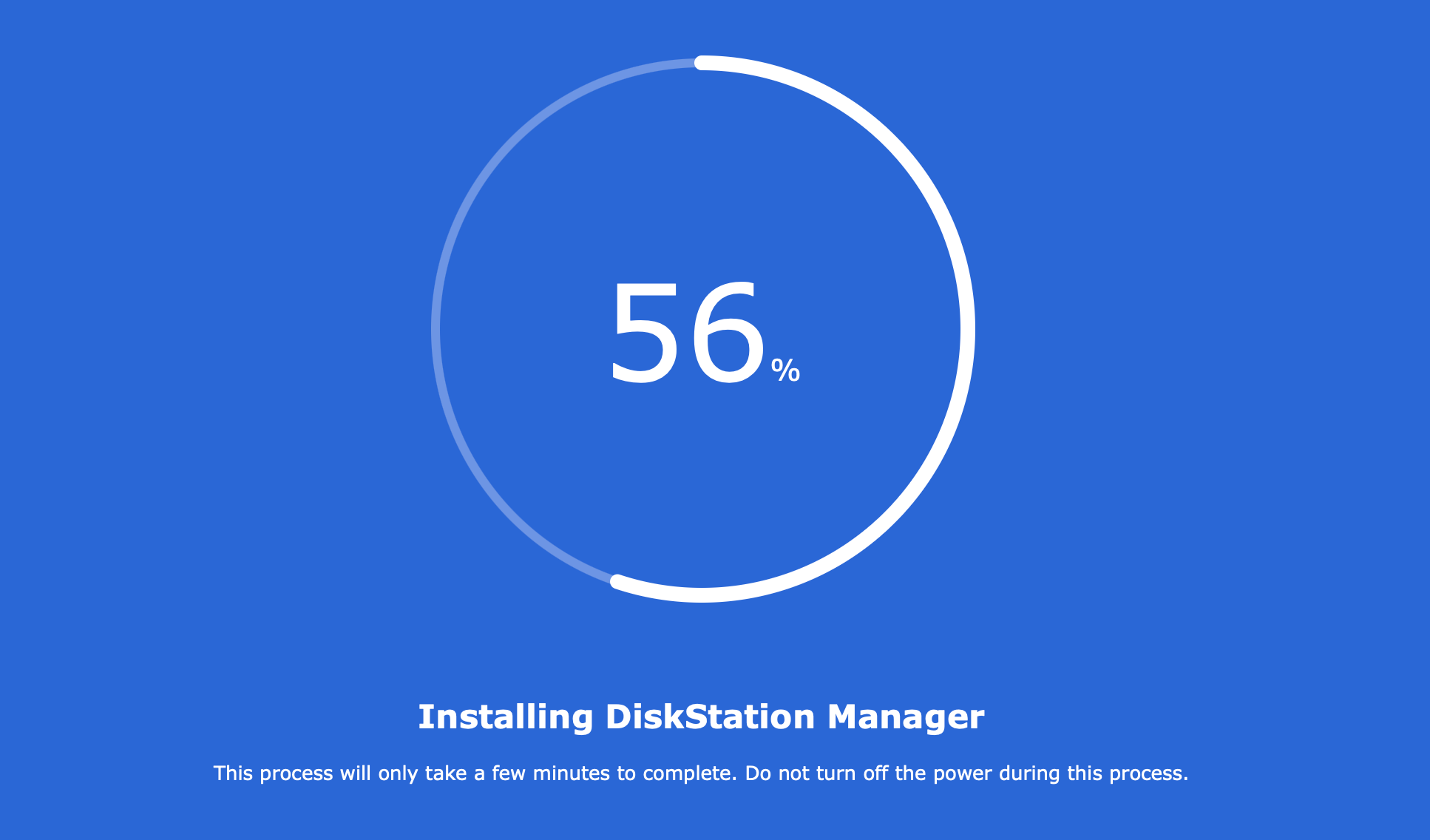
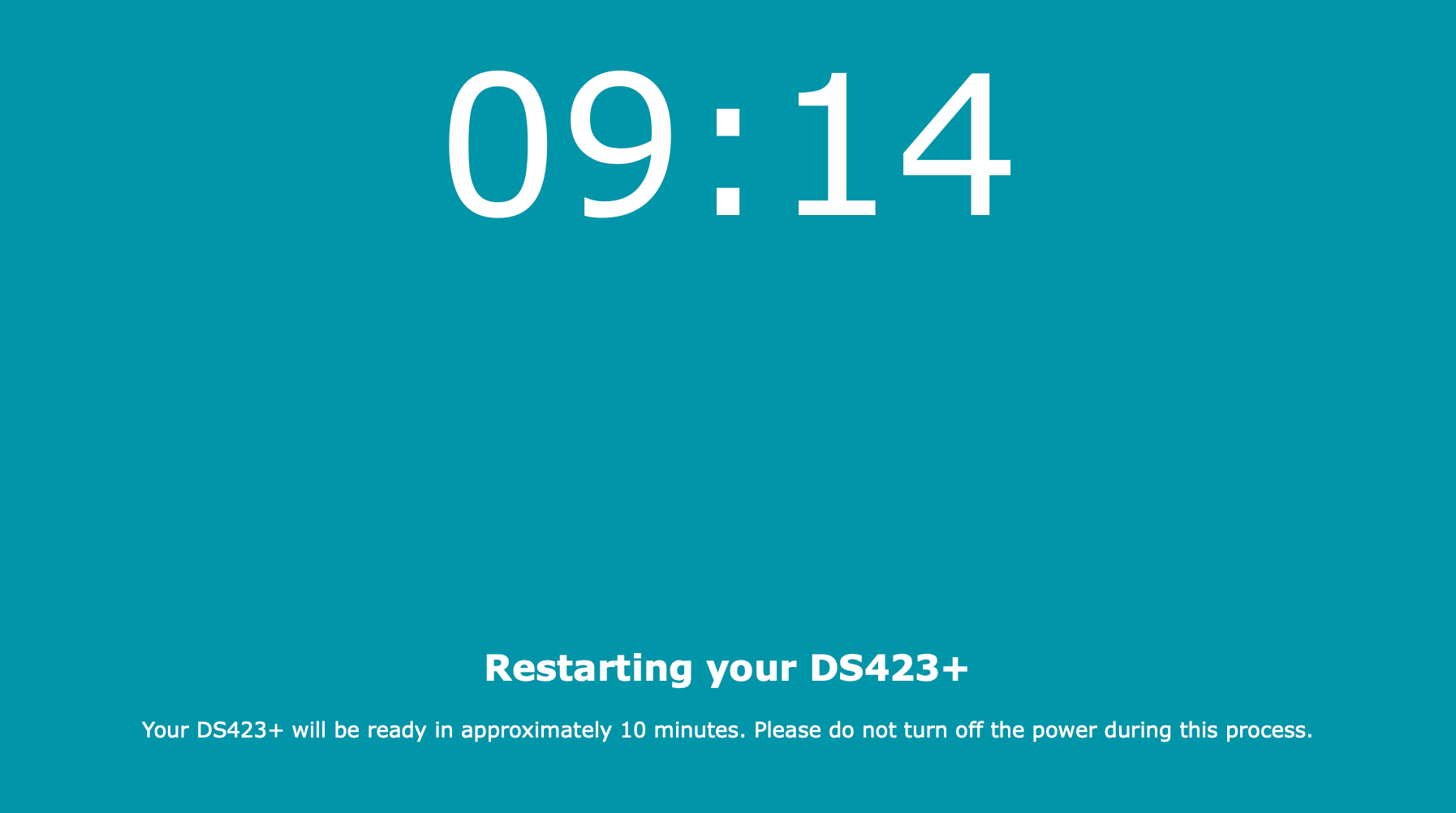
The whole process (without the reboot) took less than 2 min, so even with 2GB of RAM, the DS423+ is a nicely balanced device that will feel very fast.
Configuration of DSM in terms of accounts and initial settings will take a few more minutes after which the NAS will be ready.

Before we can continue forwards with configuration and package installation, a storage pool and volume need to be created.
For testing I have used a WD 4TB enterprise drive (gold), just to see if the DS423+ will accept it and work with it. While that was not the issue, I was hit with a warning that the drive is not on the official compatibility list for this particular NAS, but that is the risk that at the moment I am willing to take.
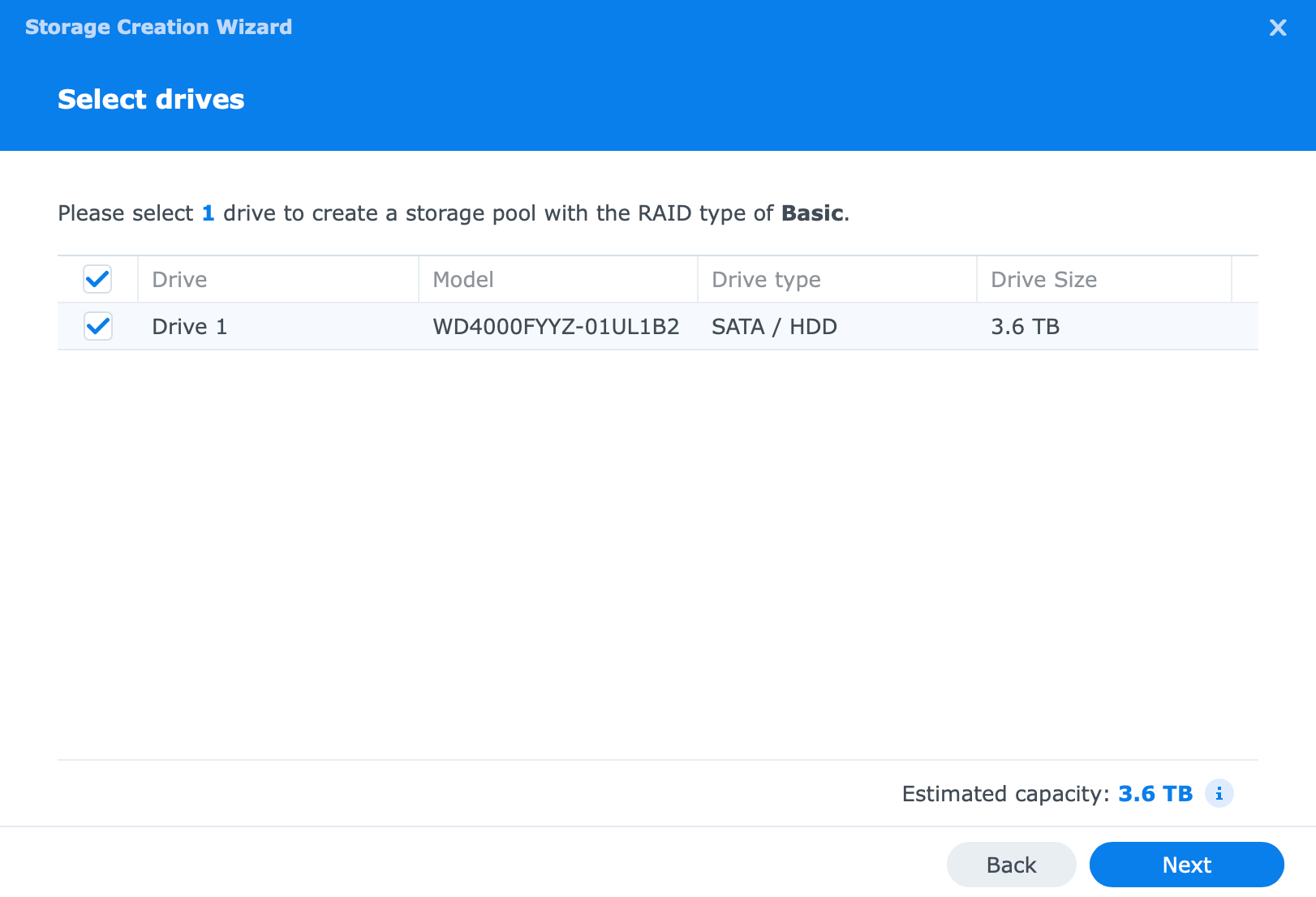
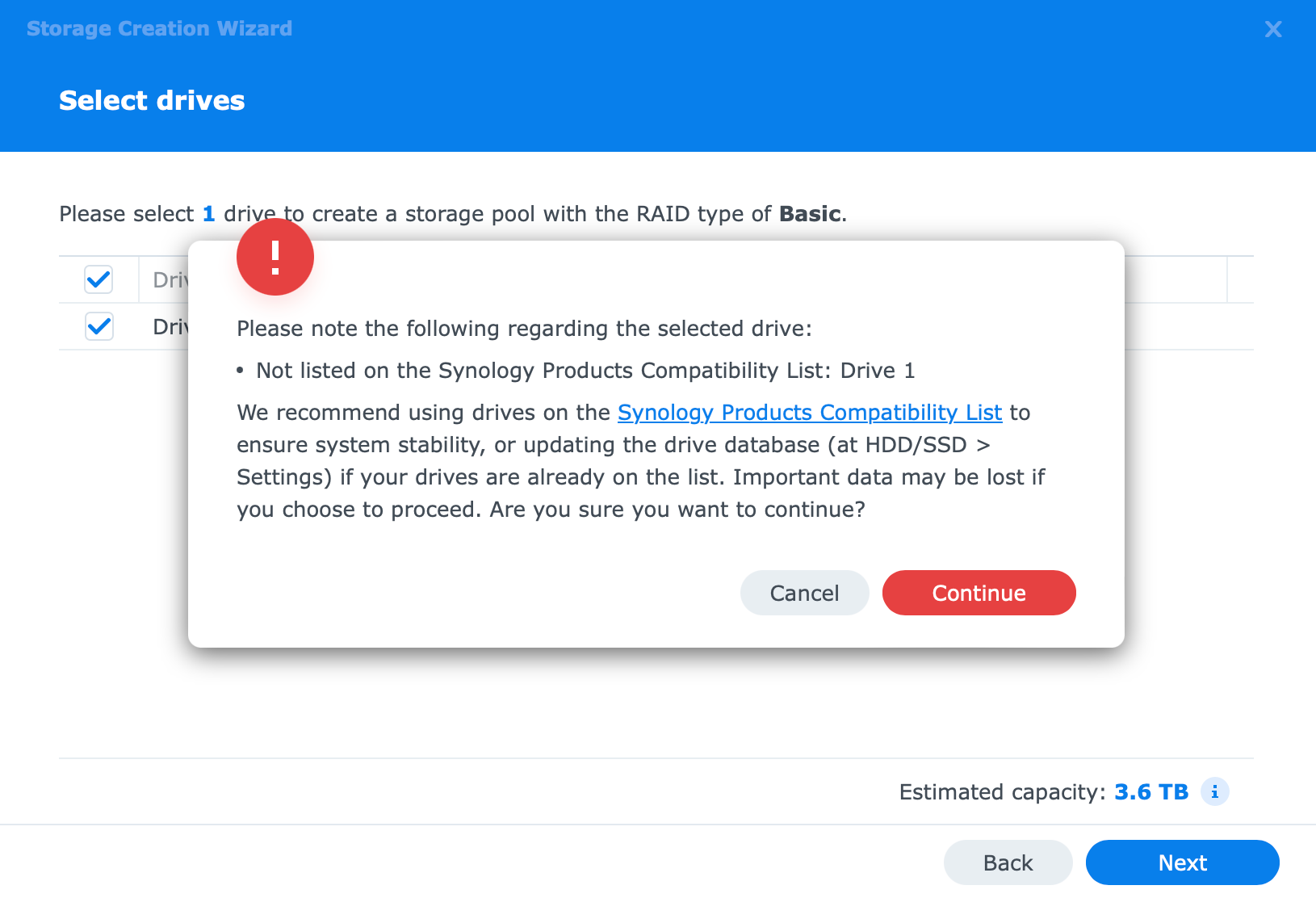
The drive is not on the compatibility list and DSM will give us a warning about it
As on any other device in this class, DS423+ supports both BTRFS as well as EXT4 partition, but considering what I would like to test on this device, BTRFS will be needed.
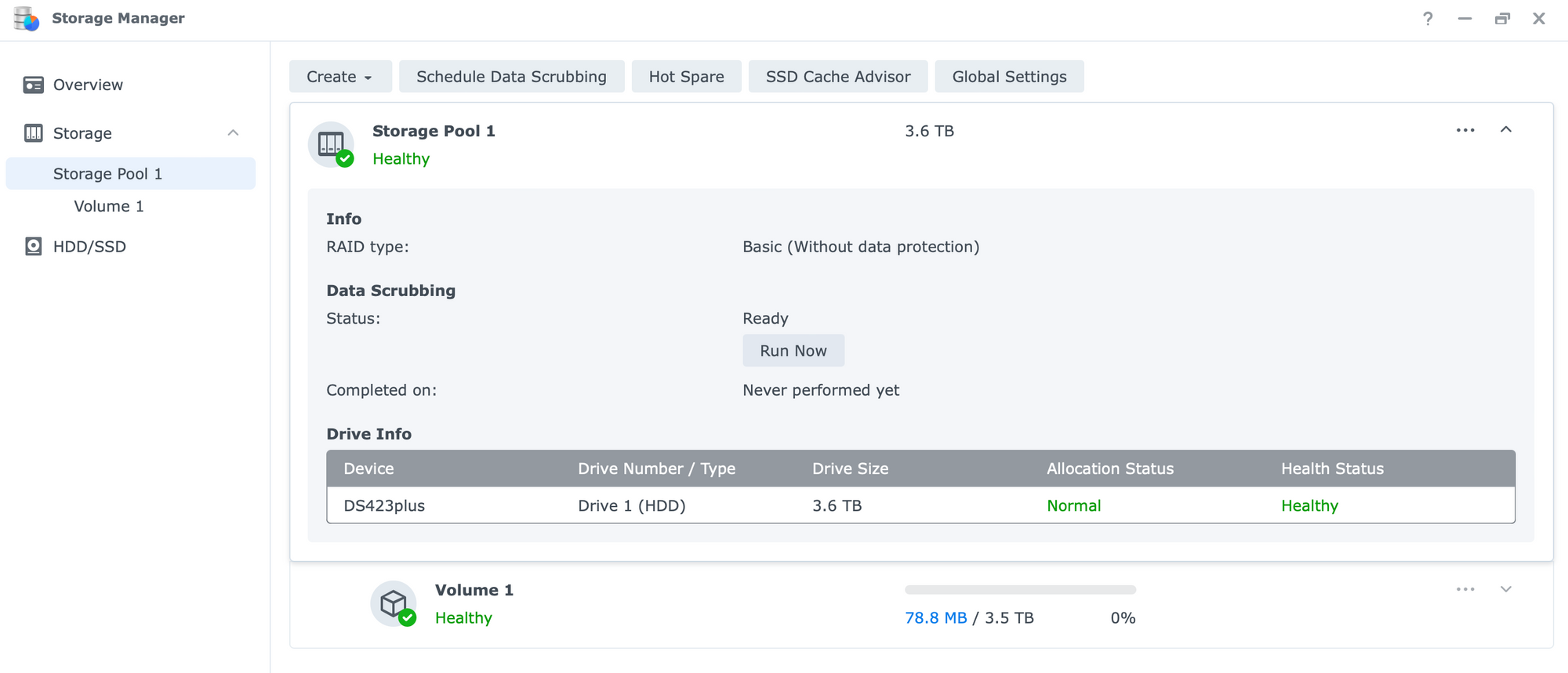
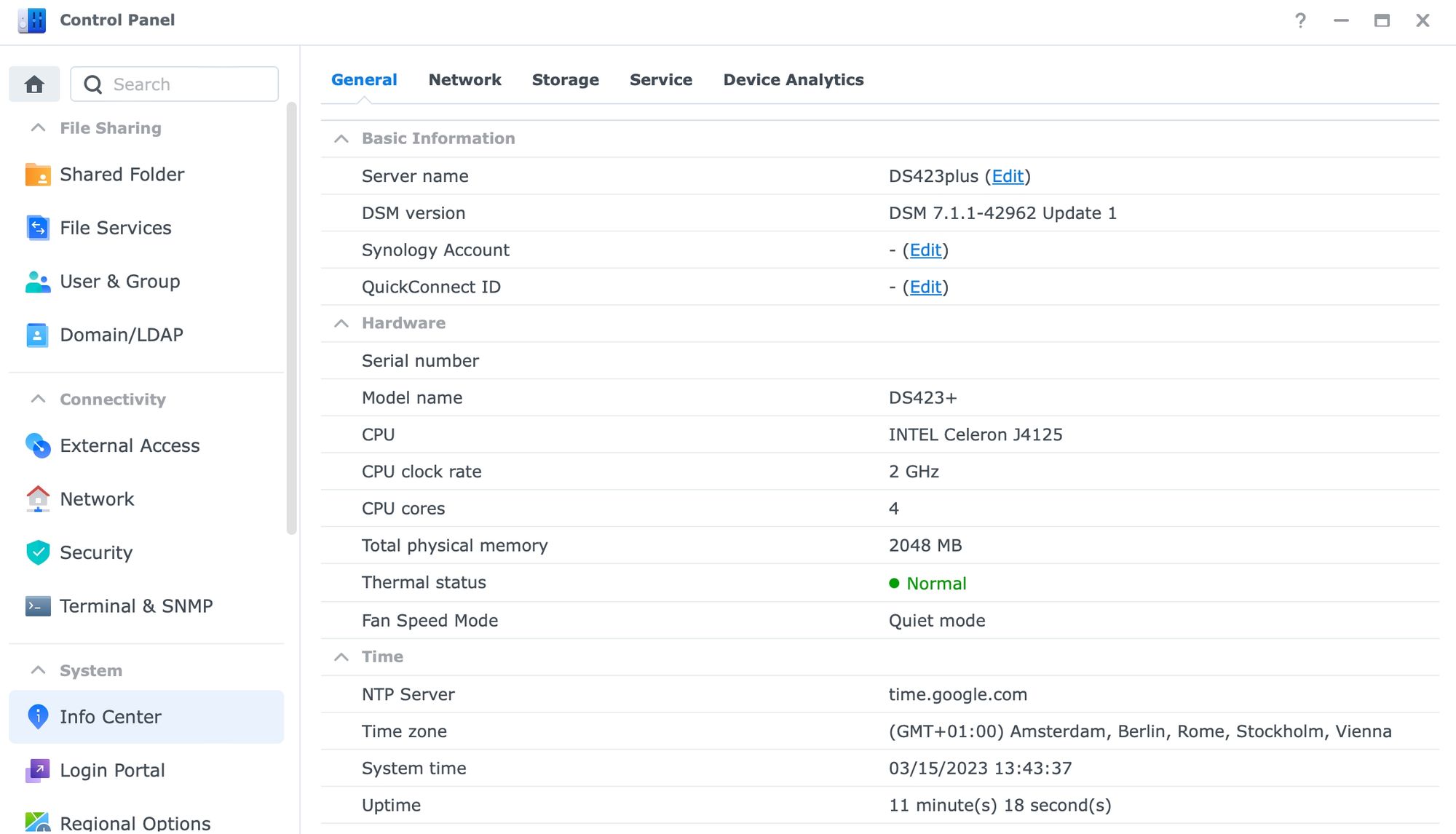
: Compatible packages & apps
Being one of the "plus" models, the DS423+ comes with a lot of perks. Upgradable RAM, network redundancy, more capable CPU, and finally, package support. Specifically, apps that are compatible with this particular model as part of the DSM itself.
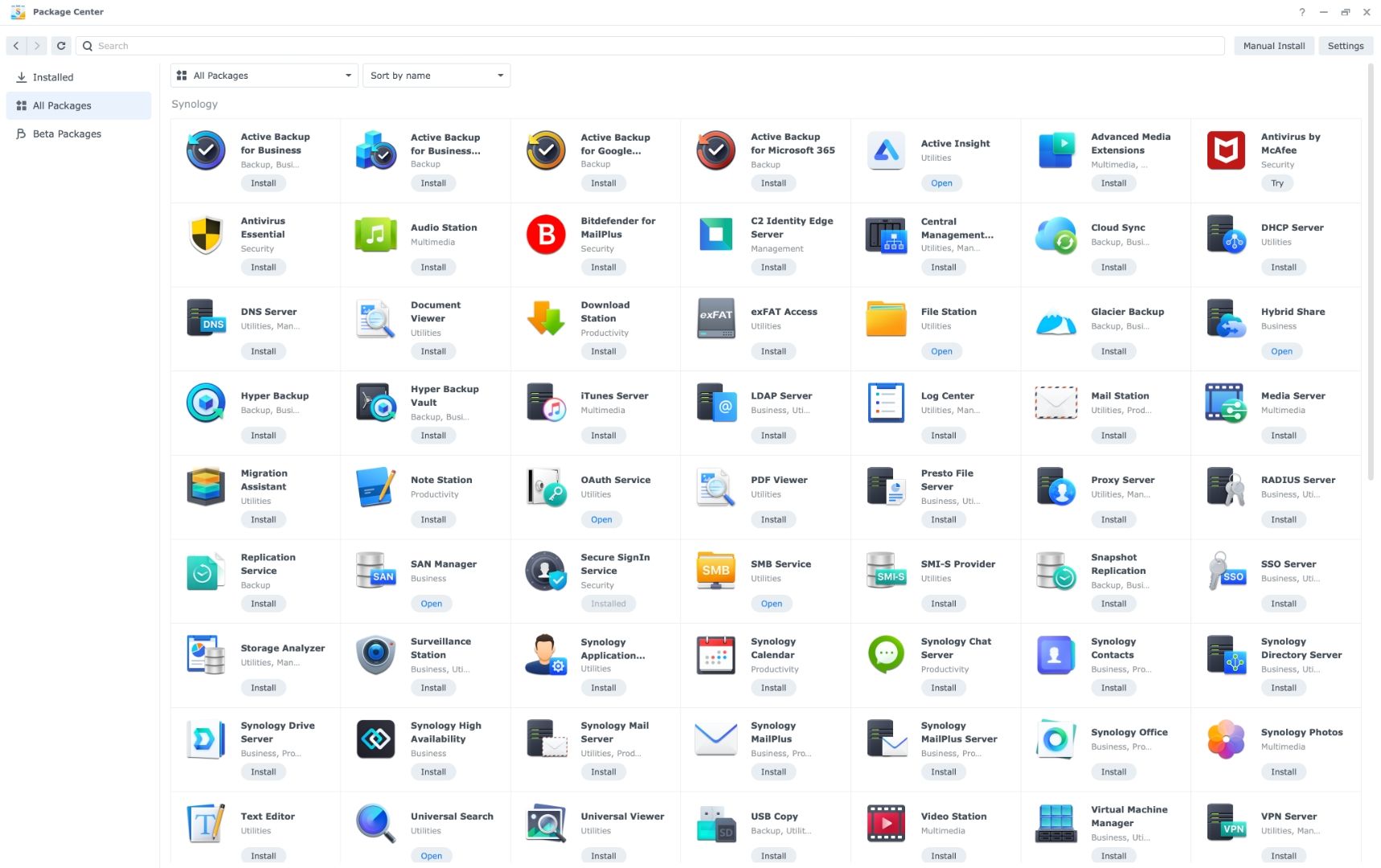
The NAS works with DSM 7 and onwards, as well as a whole list of DSM apps. Mainly those will be very popular Synology Photos, Drive, Active Backup, Hyper Backup, Snapshot Replication, and Surveillance Station to name a few.
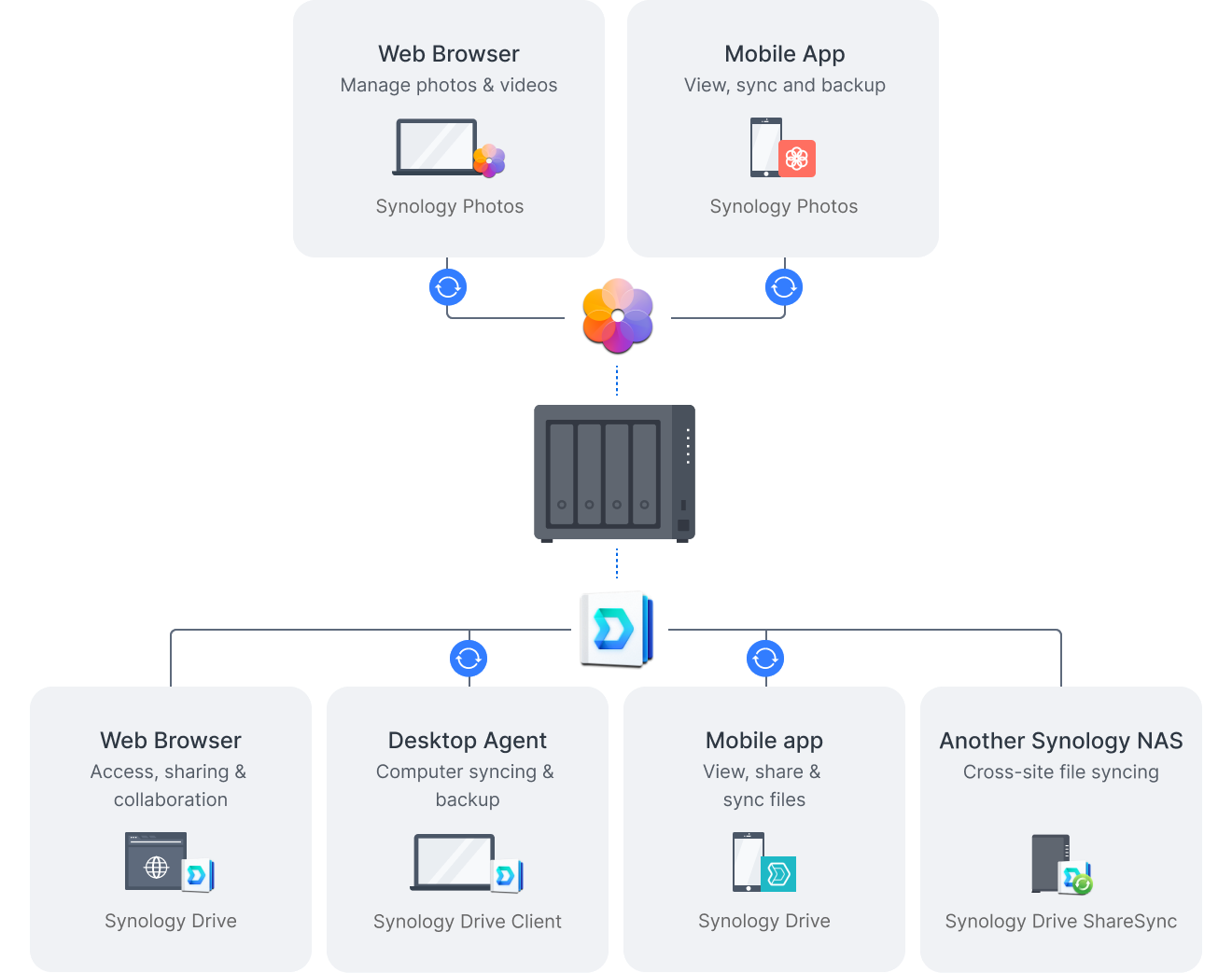


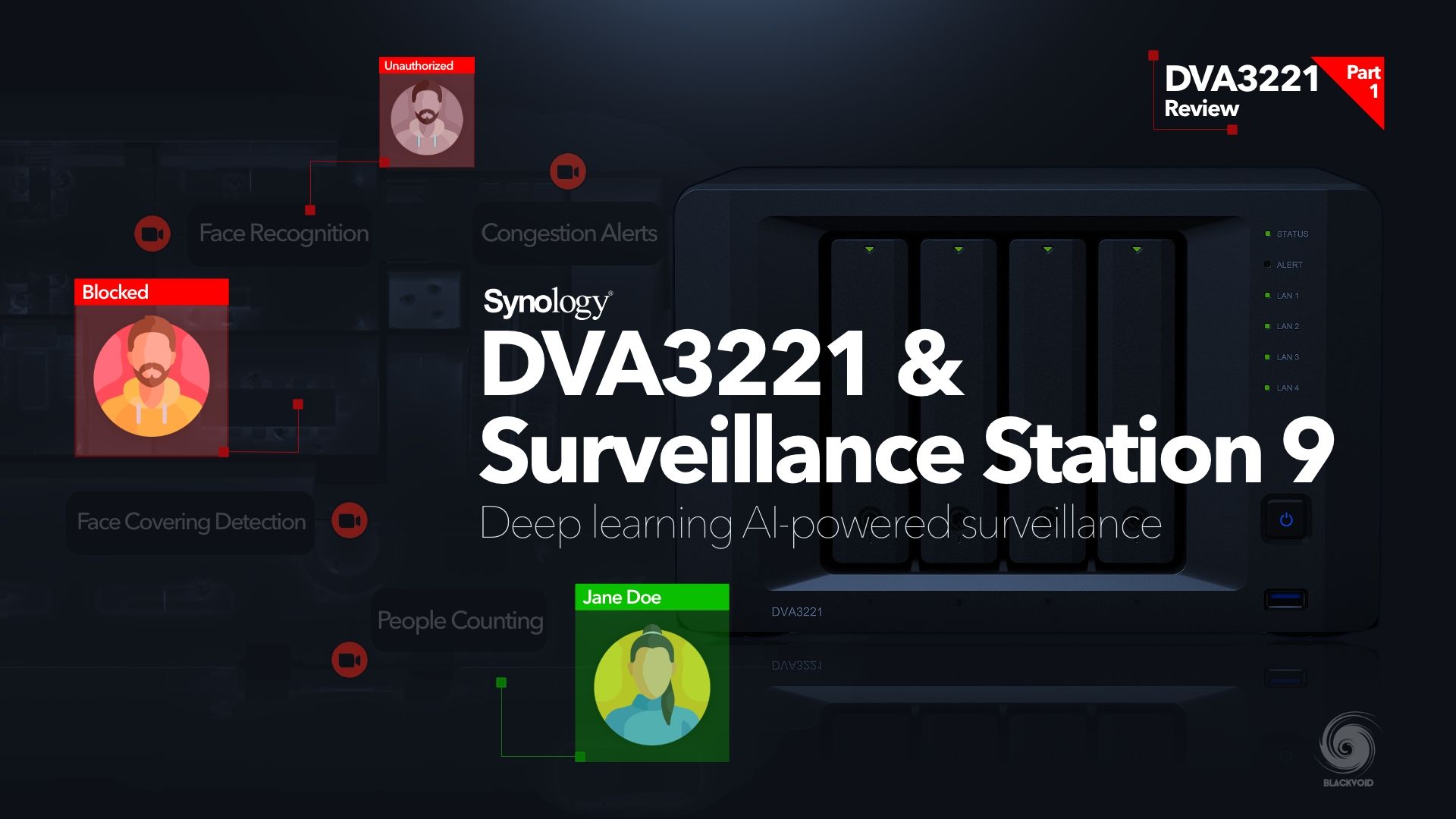
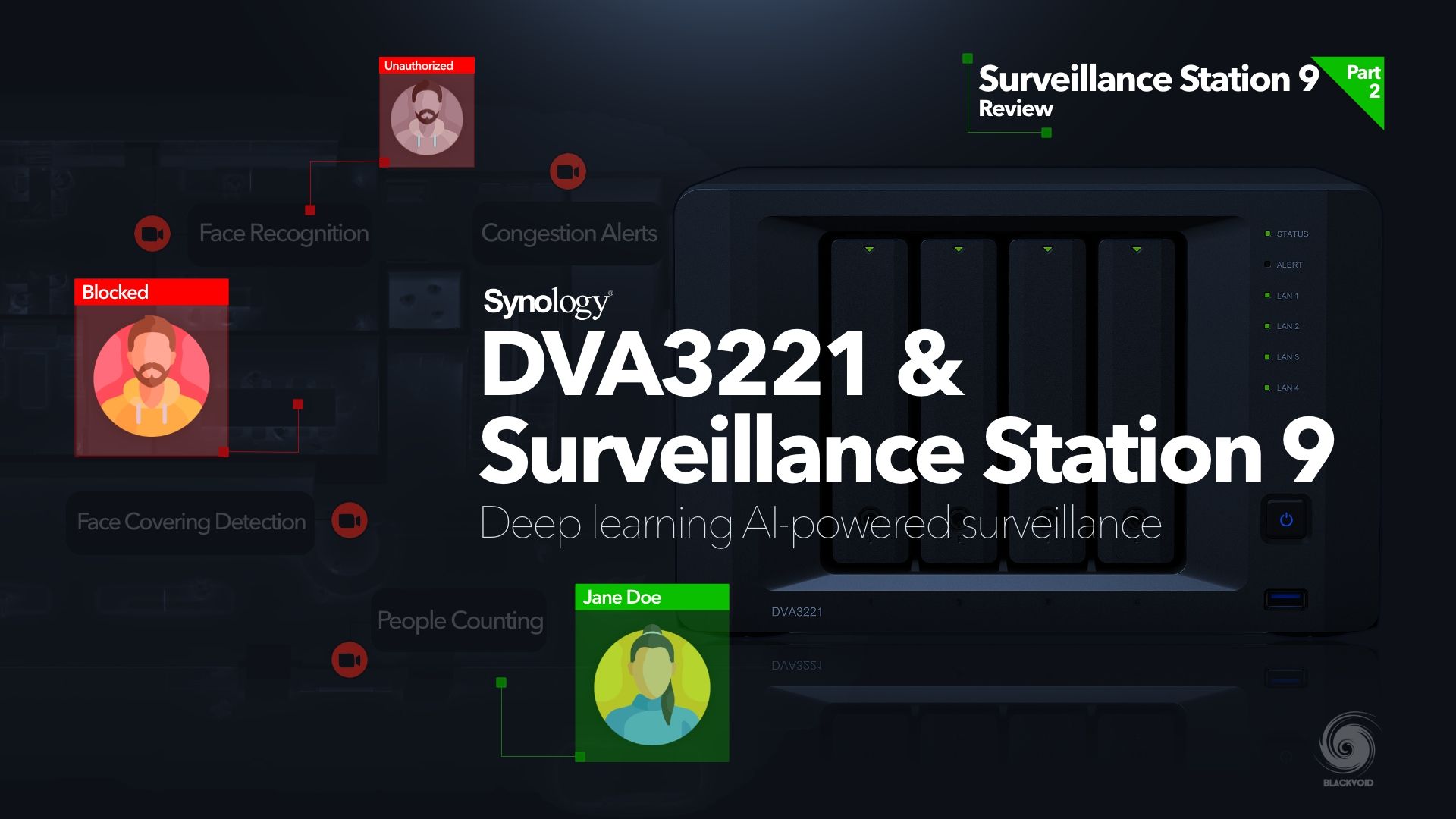
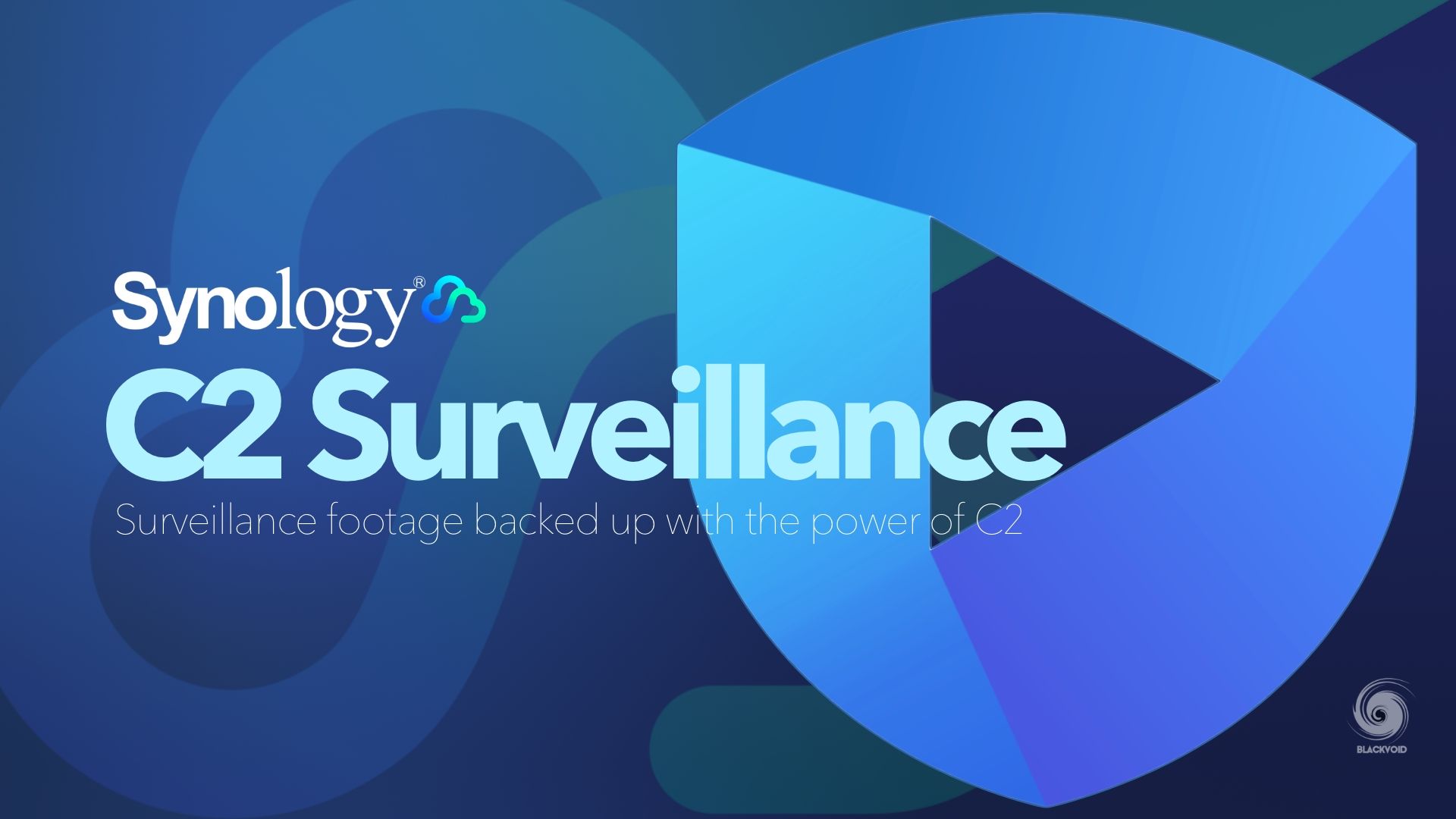
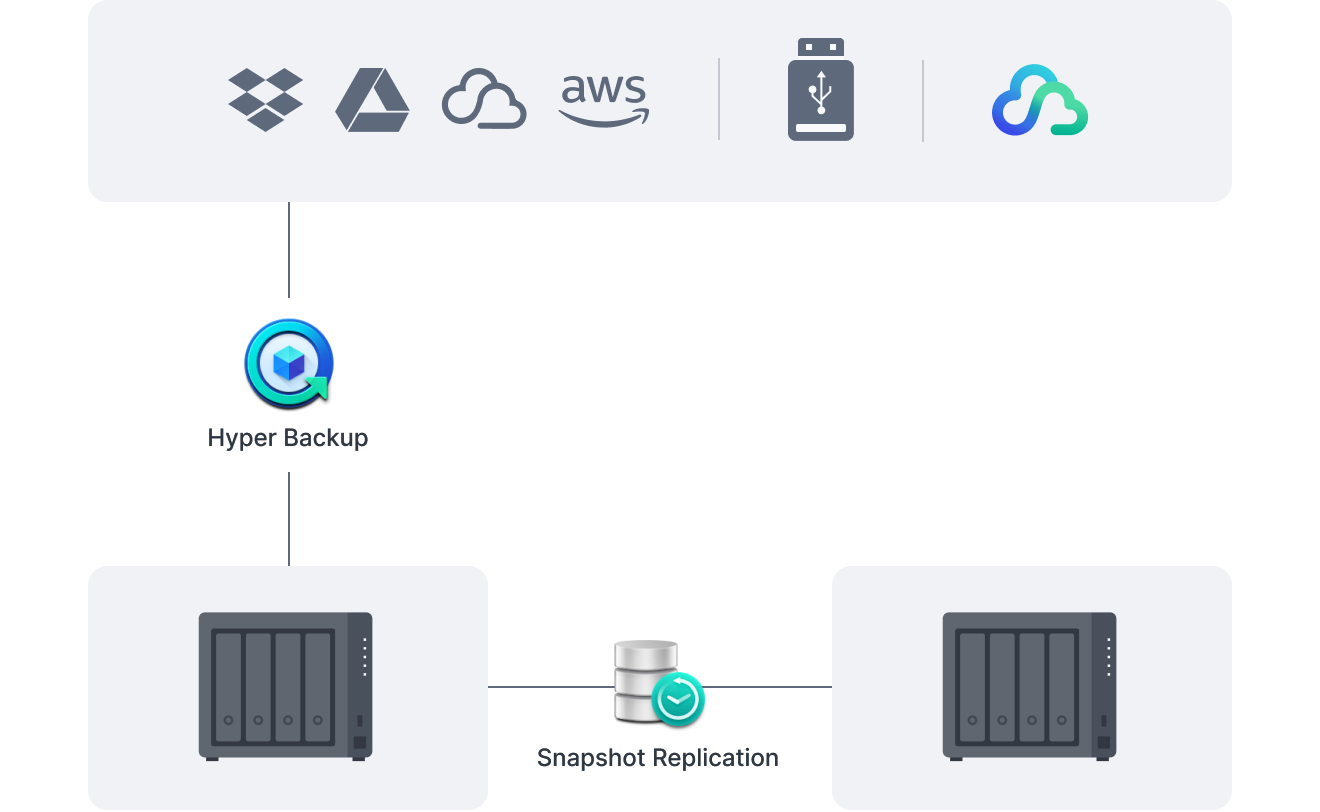
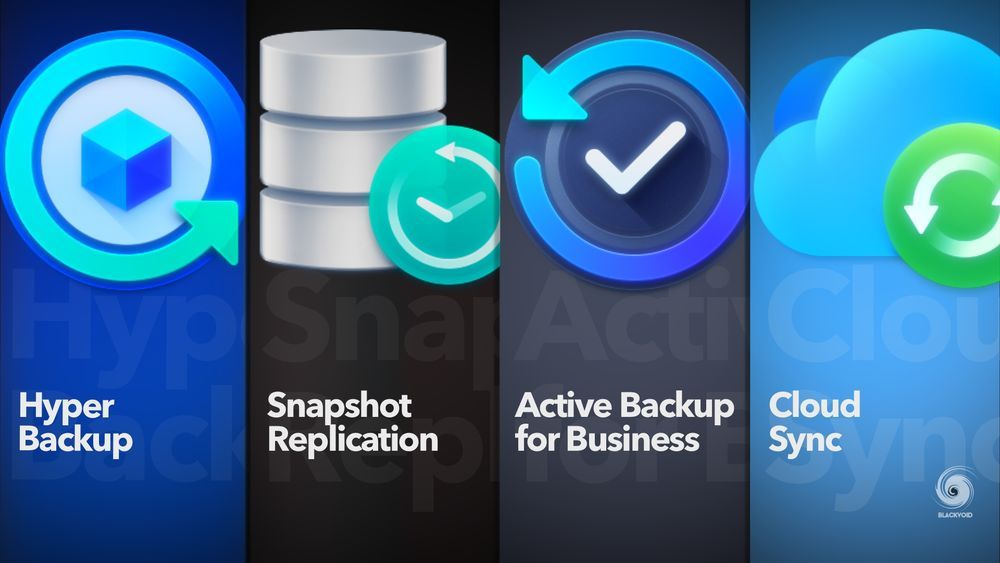

It is clear that this model can be used in a wide variety of cases, from document and media management to backup and security.
One particular package trio that is worth mentioning here is also Active Backup. Supported only on the "plus" models or better, these license-free packages are fully supported on the DS423+ further unlocking it and putting it as a front-runner for SOHO and small business setups and needs.


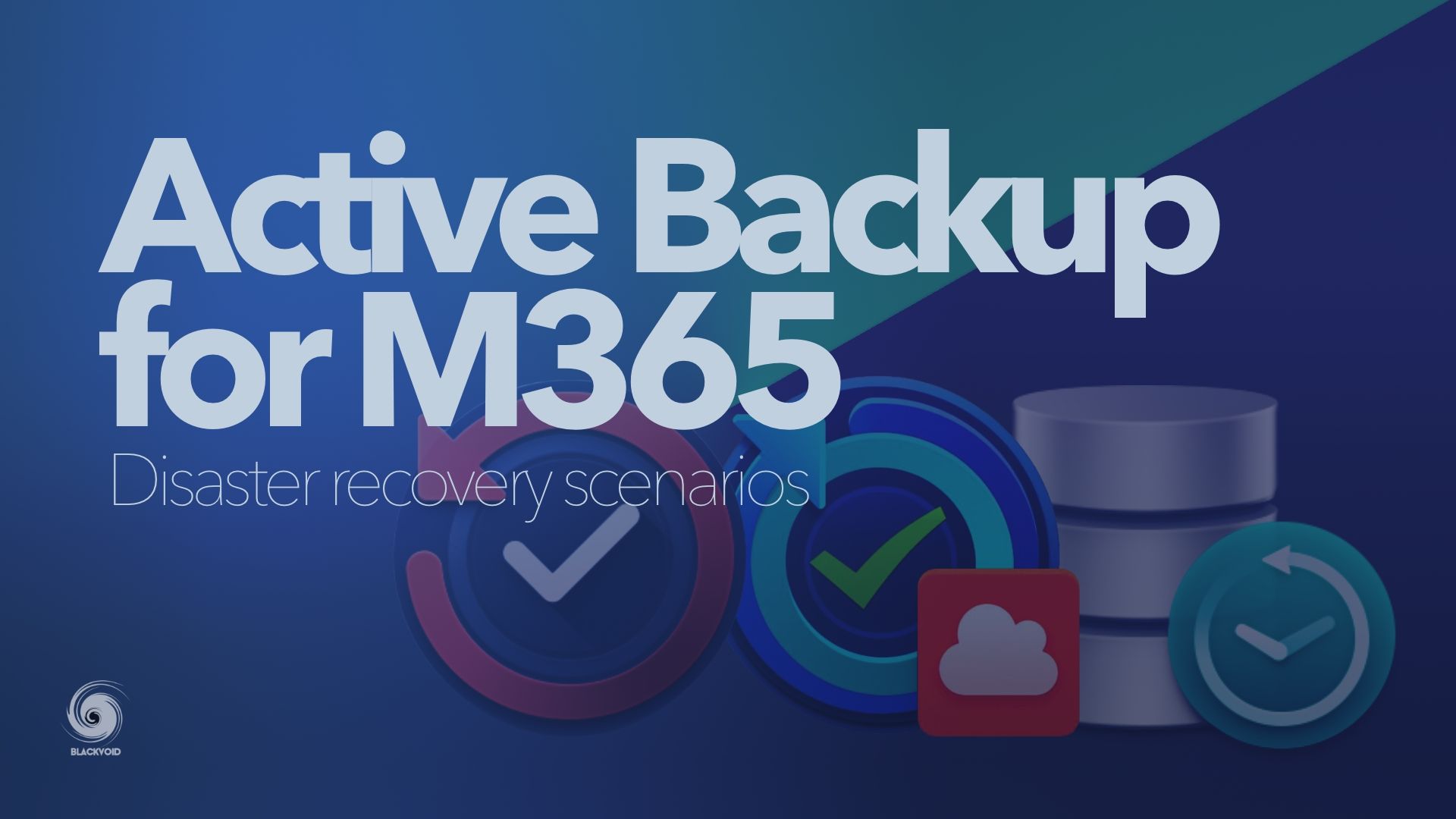
On top of all the various proprietary packages, the DS423+ supports Docker as well as 3rd party media management platforms, like PLEX.
In the upcoming DSM 7.2, the Docker package has been rebranded into Container Manager, but it is still Docker under the hood.

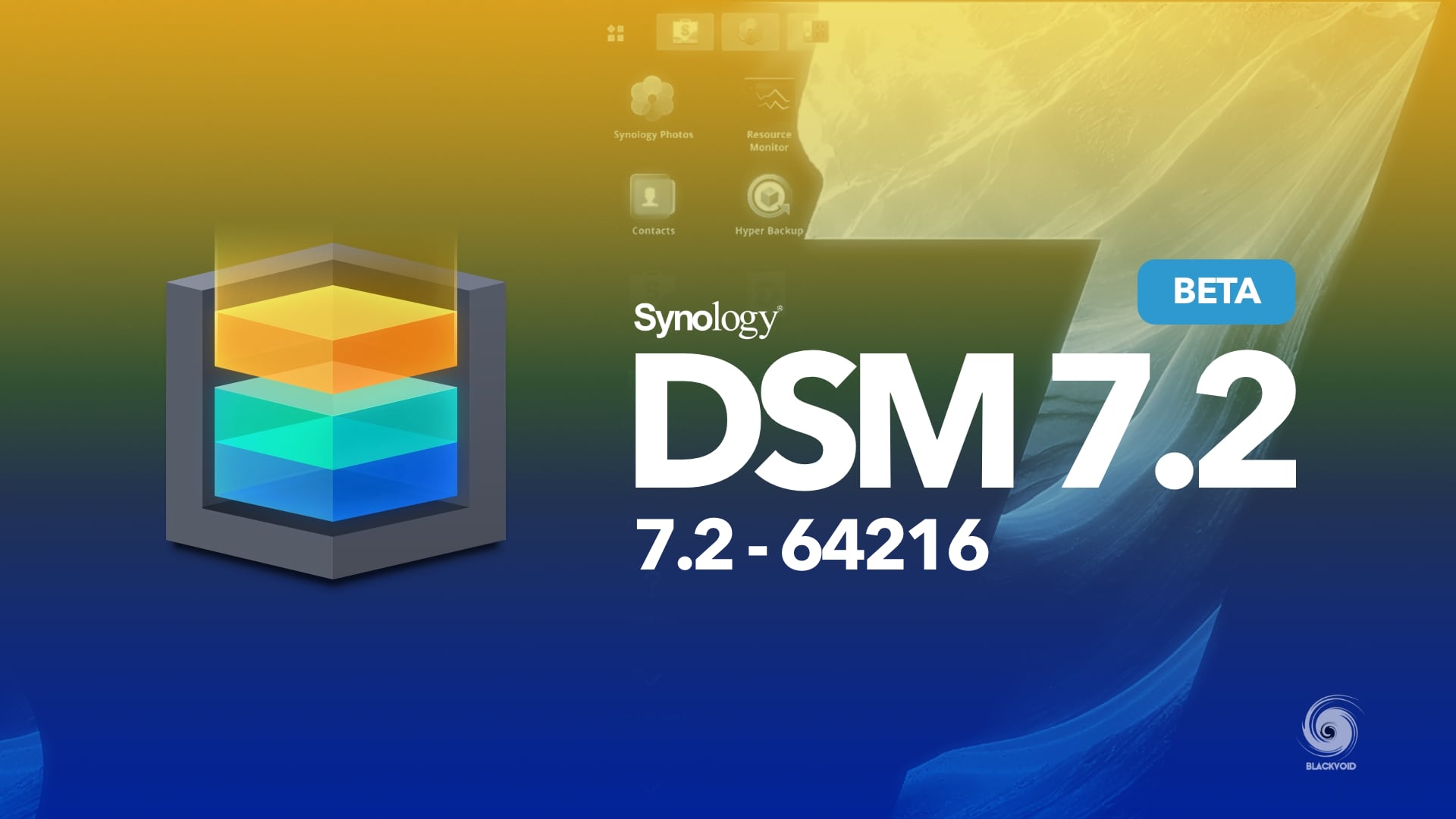
The media side of things is something that many have been waiting for from the new x23 lineup. So far, all x22 and x23 models have arrived with AMD CPUs or the new Realtek one, but non (until DS423+) had an Intel-based CPU. This is important for those that want to run PLEX-like platforms in order to take the advantage of the Intel QuickSync feature that this Celeron CPU has. It allows for hardware transcoding options that unlock great potential for such a compact and low-power device.
More on the actual PLEX testing later in the review.
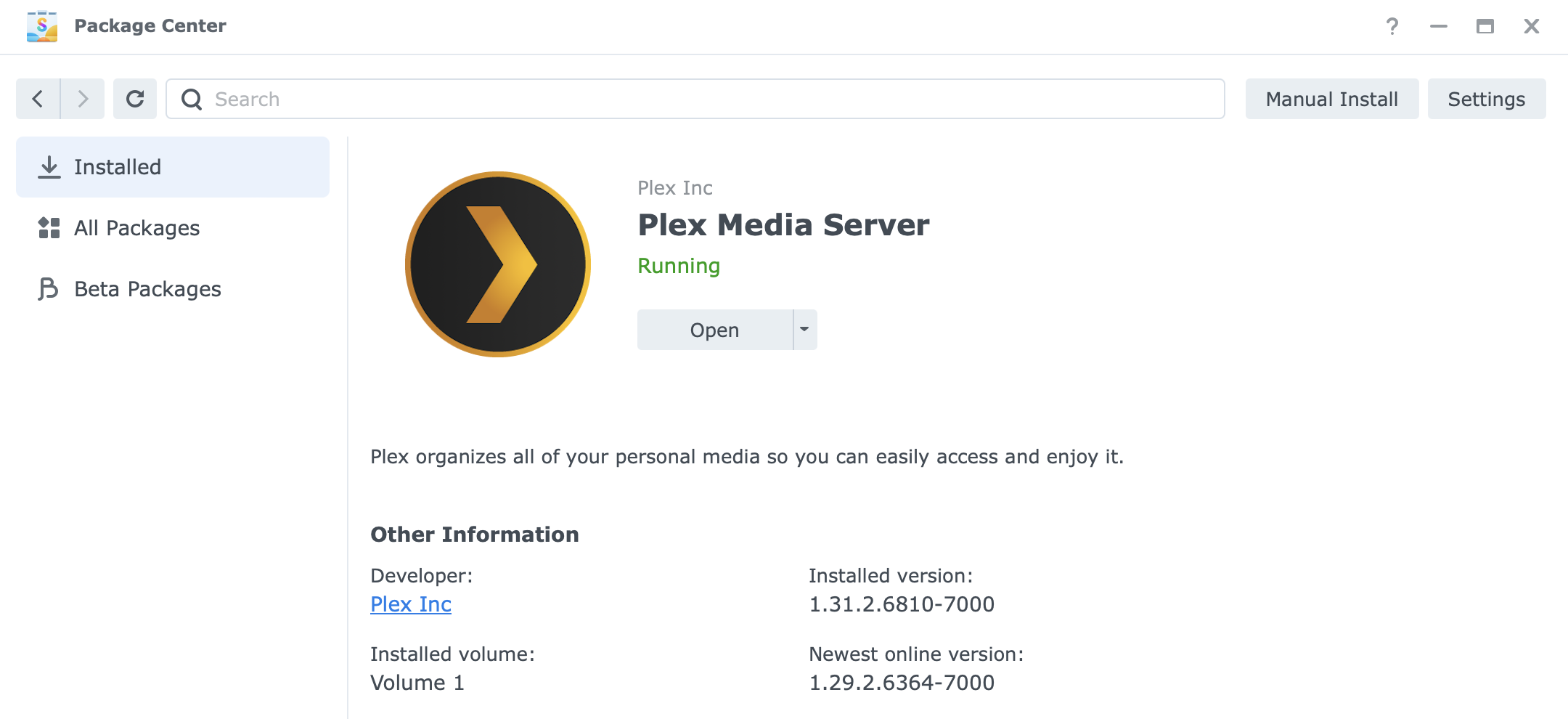
It is great that Synology has decided not to skip on this support as this particular model (and maybe the upcoming DS223+) is the only one that will allow for video and audio transcoding that will not kill the CPU with software-based one, and rendered the device useless for anything else. As much as this feature, on previous models, was part of the DS9 and DS7 series (DS920+ or DS720+), that is no longer the case, so it is great to still have a model that is very capable and versatile, while maybe not offering the 10G and more horsepower as some of the new x23 NAS devices do.
: Speed tests
In terms of speed, this NAS can deliver enough when it comes to network transfers with 1GbE (100MB/s) or with the use of the new SMB multichannel option up to 200MB/s between compatible platforms. Do note that multi-channel is still not supported via DSM's File Station and remote share, so to utilize it there will be a need to run it against a compatible OS like Windows, or macOS that support it.
[ ID] Interval Transfer Bitrate
[ 5] 0.00-1.00 sec 107 MBytes 898 Mbits/sec
[ 5] 1.00-2.00 sec 112 MBytes 941 Mbits/sec
[ 5] 2.00-3.00 sec 112 MBytes 941 Mbits/sec
[ 5] 3.00-4.00 sec 112 MBytes 941 Mbits/sec
[ 5] 4.00-5.00 sec 112 MBytes 941 Mbits/sec
[ 5] 5.00-6.00 sec 112 MBytes 941 Mbits/sec
[ 5] 6.00-7.00 sec 112 MBytes 942 Mbits/sec
[ 5] 7.00-8.00 sec 112 MBytes 941 Mbits/sec
[ 5] 8.00-9.00 sec 112 MBytes 941 Mbits/sec
[ 5] 9.00-10.00 sec 112 MBytes 941 Mbits/sec
[ 5] 10.00-10.05 sec 5.43 MBytes 941 Mbits/sec
- - - - - - - - - - - - - - - - - - - - - - - - -
[ ID] Interval Transfer Bitrate
[ 5] 0.00-10.05 sec 1.10 GBytes 937 Mbits/sec
Standard iPerf test will prove that the NAS is capable of utilizing its 1GbE speeds to their full potential, while SMB transfers with large files are resulting with similar speeds (at about 100MB/s).
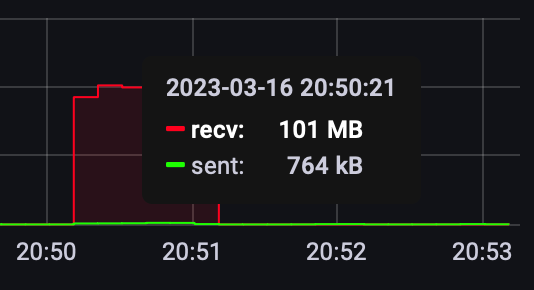
An example of a mixed transfer of about 57GB of data, took just under 10 min total to complete while having a mostly sustained transfer rate of 100MB/s.

While doing an HB task for the same content (and size), the speed is for the most part consistent.

Considering that I have had no SVN Synology NVMe drives on hand I was unable to create a user-usable NVMe volume in order to see the performance of those drives in this particular machine, but even so, in the DS923+ model, the best-case speeds that were tested came in around 1GB/s. So anything close to that, due to the fact that here we have a slower CPU, might be considered a win.
Without any additional RAM, VMM (Virtual Machine Manager) was also not an option, so VM speeds were also not an option, but the DS423+ does indeed support that particular hypervisor and will give a decent one-VM machine experience if needed. Personally, I would not recommend using this NAS as a VM machine, as it will be an "expensive" hypervisor with not much to offer in that department. Also, running a VM will take quite a big performance hit on any other service that might be running on the same device.
: Media streaming and transcoding (PLEX)
Just a reminder, this NAS has the same CPU as the DS920+ meaning that it is capable of hardware transcoding using Intel QuickSync which Celeron J4125 has support for.
That means that DS423+ is a very capable PLEX server. By default, it can serve any content needed, but if a particular PLEX instance has a PLEX Pass feature activated, that will then change this NAS into a transcoding station if needed. Any need for remote streaming using a client that does not support the native resolution or codec (audio or video) will require some sort of transcoding on the part of the server.
PLEX Pass will unlock the ability to use the Intel QuickSync tech and transcode the content without too much strain on the CPU and the NAS.
4K content
Using multiple clients and streaming the same content has resulted in the following performance:
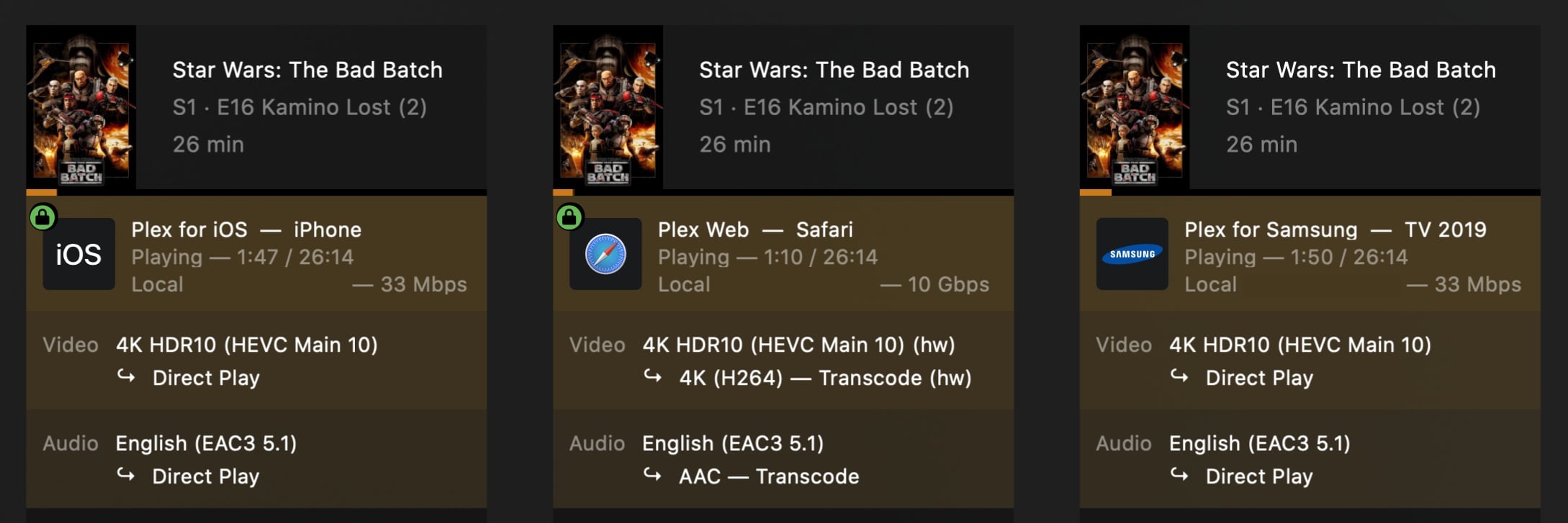
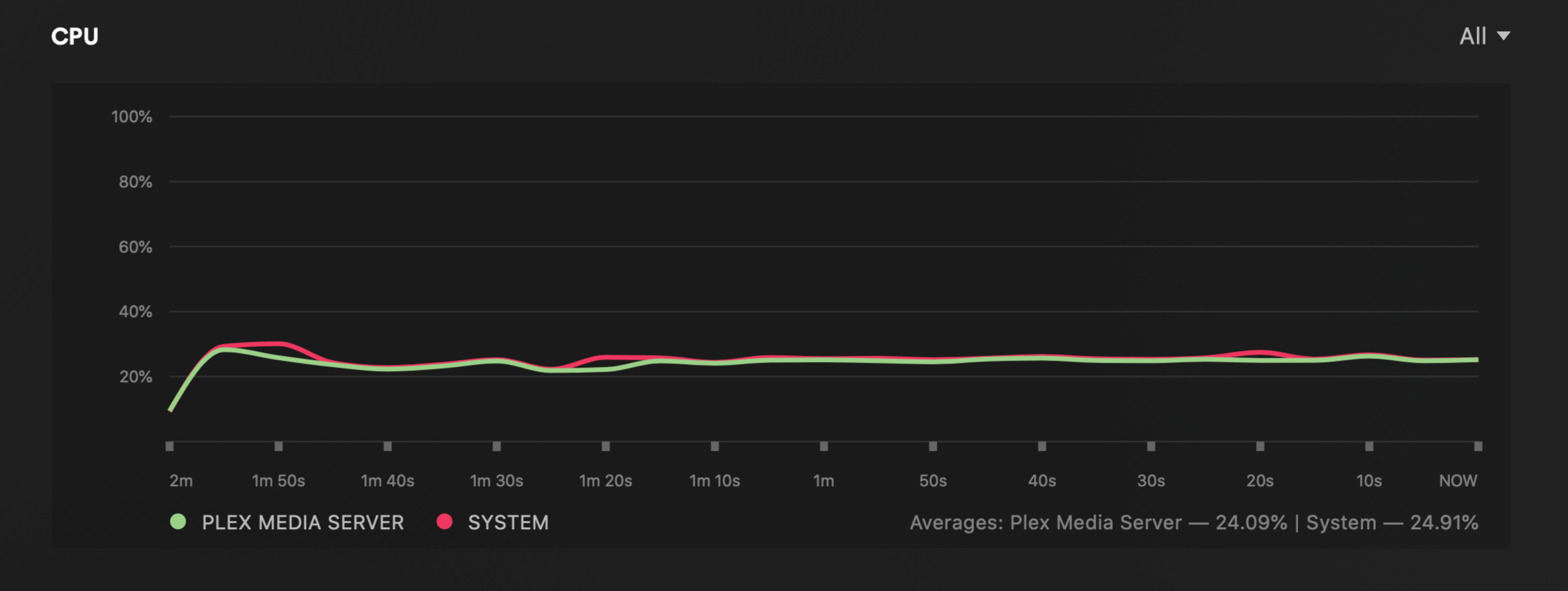
This test (as all the others as well) included an iPhone 11, a Macbook pro (Safari), and a Samsung 65" TV all using the official Plex app (apart from the Macbook as it streamed via a browser).
As can be seen from the performance chart, the CPU was consistent at about 20% utilization with zero issues in terms of playback.

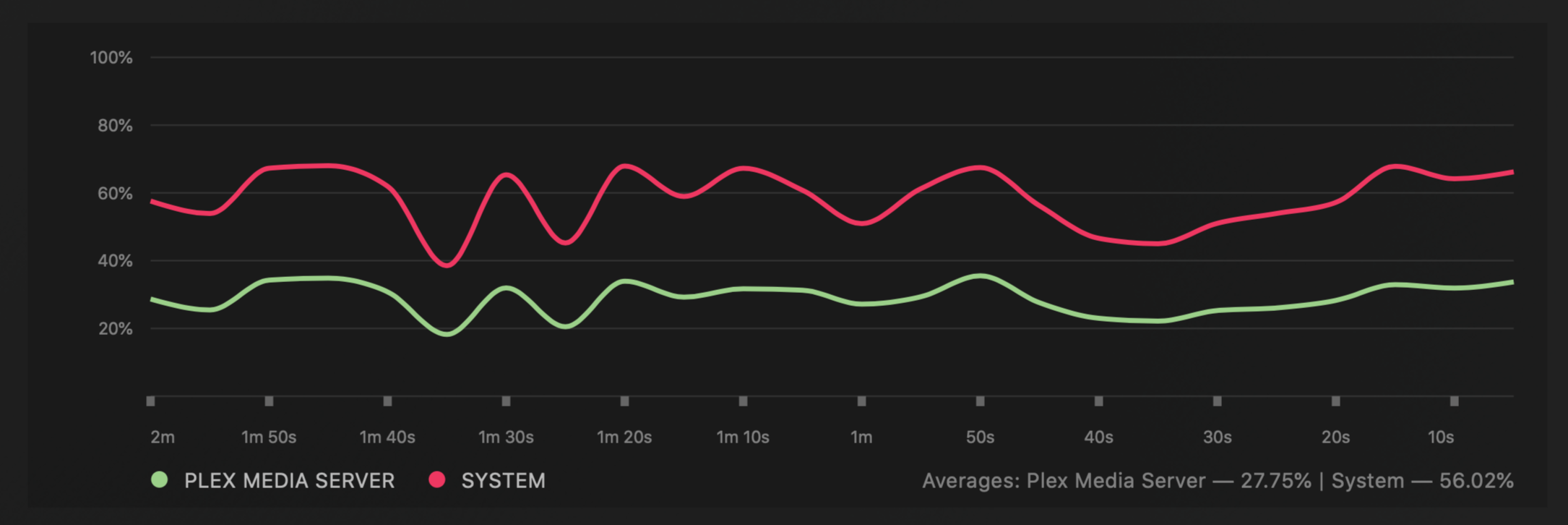
When manual transcoding was activated (4K down to 1080p) for only a single stream, a total of two out of three streams started to buffer out and playback was not pleasant at all. While the CPU still had some breathing room it was enough to cause problems for the clients streaming the content.
1080p content

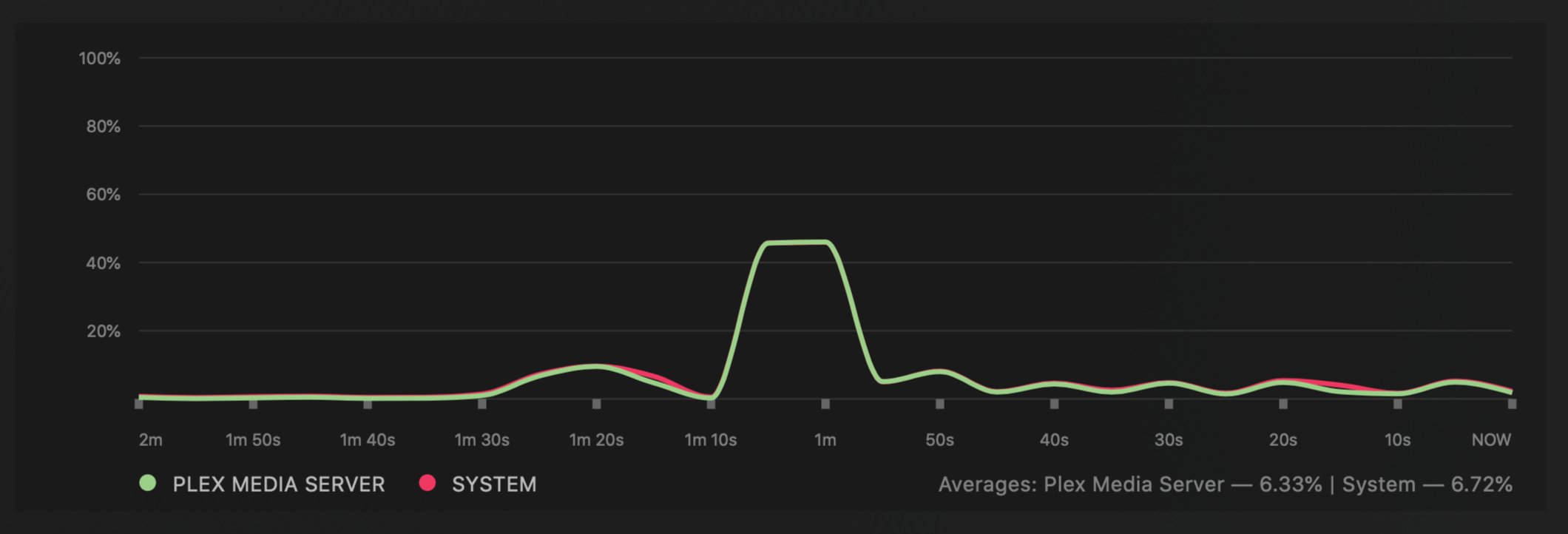
Moving into 1080p content we again see that with no transcoding at all, the CPU utilization is almost none existent. Considering how much CPU is left, this NAS has a lot to offer.
Staying with 1080p but pushing them down to 720p will still result in a great performance and show how this machine is more than a capable media server.

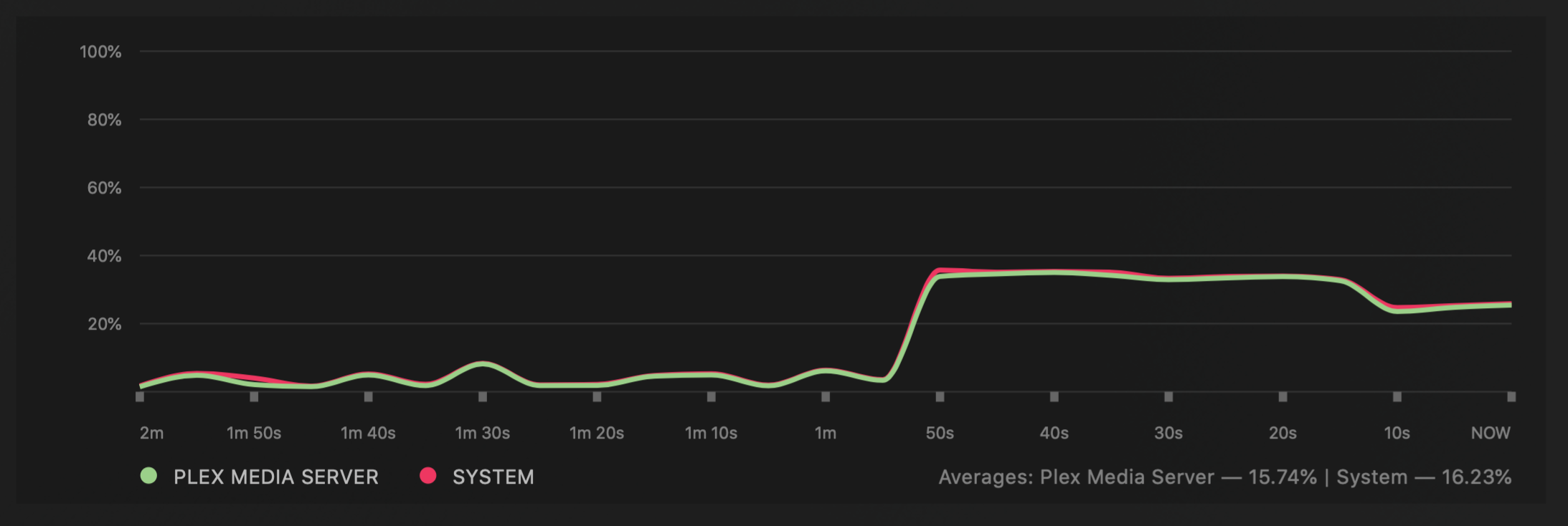
We can see that forcing transcode is at about the same CPU utilization as with three 4K streams, 20-30%.
All in all, as expected considering this is a true and tested CPU, the DS423+ with Plex Pass and hardware transcoding is a very good media server device, and it will allow for a great multi-stream experience across multiple devices and clients.
: Conclusion
While many were already aware of the potential of this NAS device just by looking at its CPU and RAM, the DS423+ brings more to the table than its predecessor. Especially in regard to NVMe support for user-usable volumes, as well as better USB speeds. The main thing for most is the fact that Synology chooses to stay on the Intel-based CPU for this class of devices, giving the option to continue using it as a media center device.
Being priced lower than the DS923+, and with no expansion or 10G options, if anyone is in the market for a low-noise, low-power device with lots of features and enough bays to offer a huge amount of space, the DS423+ is a perfect choice!
With a wide range of drives and essentially complete Package Center app support, this NAS will be a great addition for any small team or a home setup of any size and demand.
Let me know in the comment section below how you find this NAS, and do you see it as your next device!





